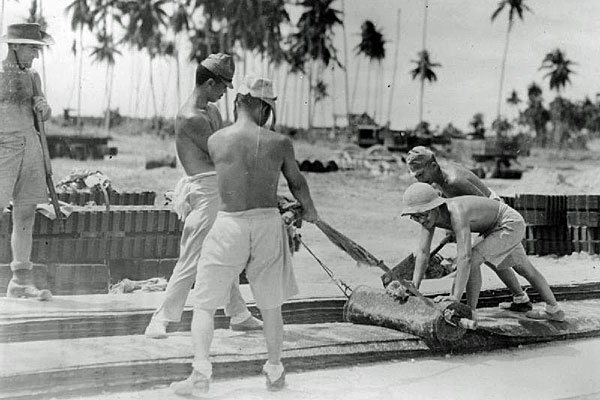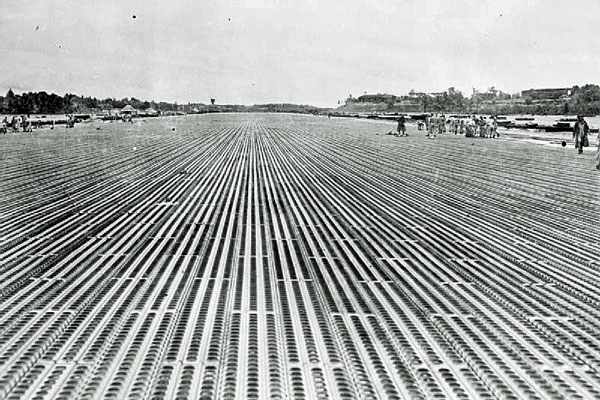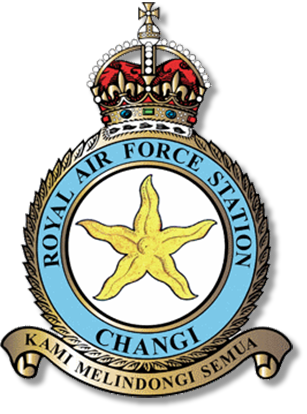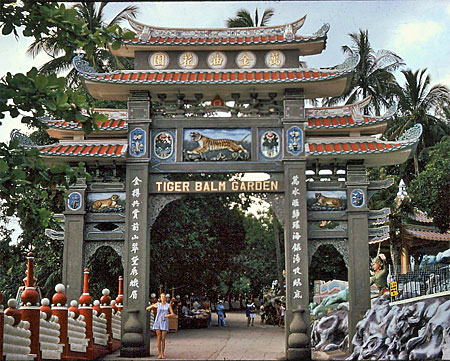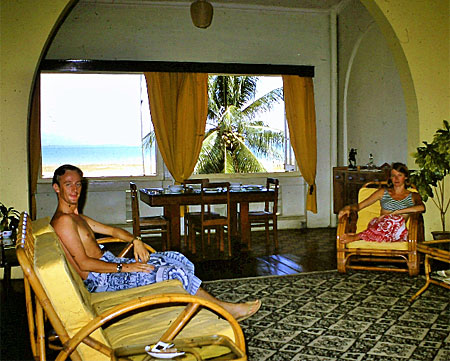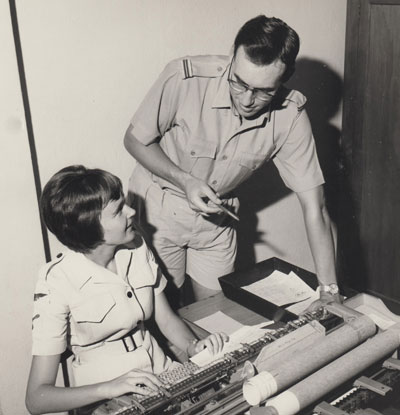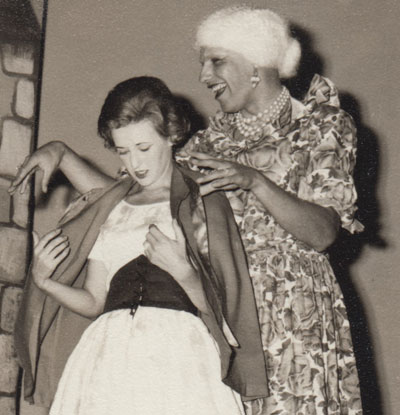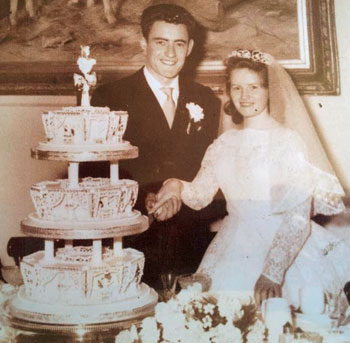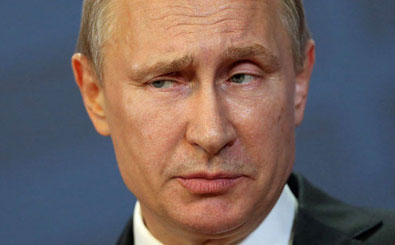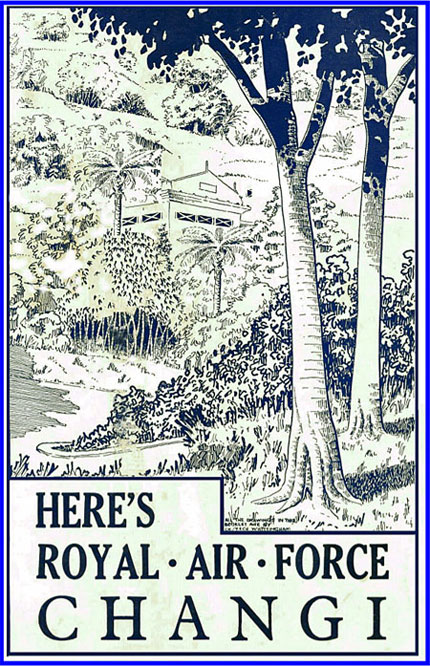



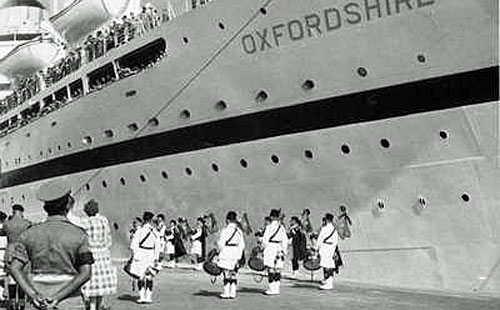
The troopship "Oxfordshire" took 4 weeks from Southampton to Singapore
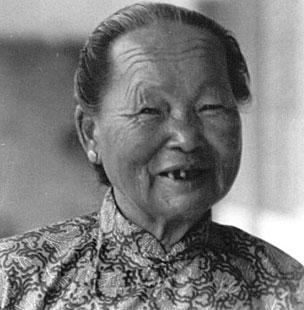
Sew-Sew - repaired clothes for just a few cents
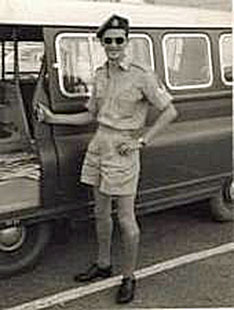
That's me with "my" RAF Bedford Transit van
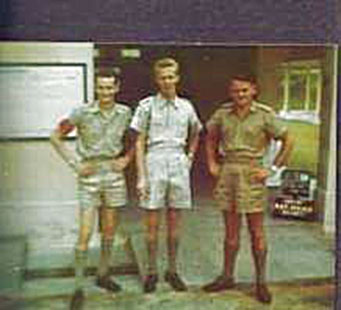
That's me on the left, in the middle is an RAF Policeman and the guy on the right was a caterer from the hotel. Notice the different uniforms. The caterer is wearing stock-standard RAF tropical issue
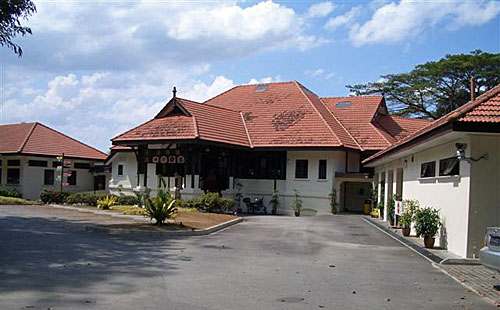
Changi Creek - RAF Transit Hotel
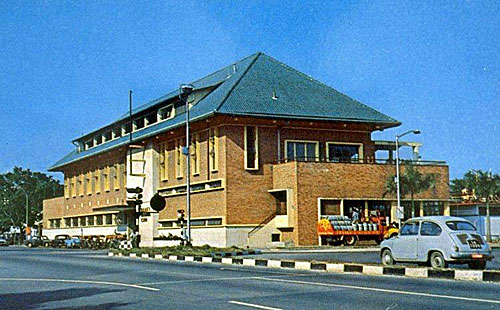
The Britannia Club - for Other Ranks
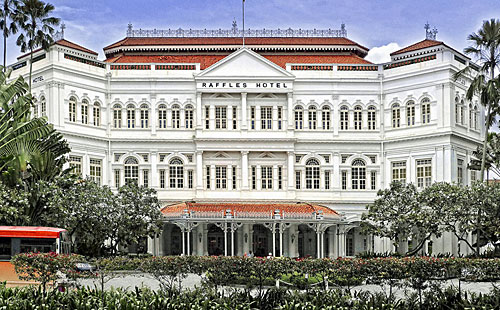
Raffles Hotel - off limits to other ranks
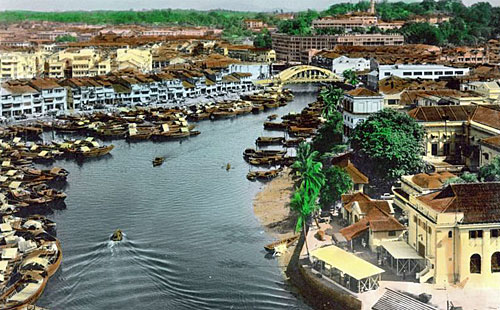
Singapore Town - as it was in the 1950's
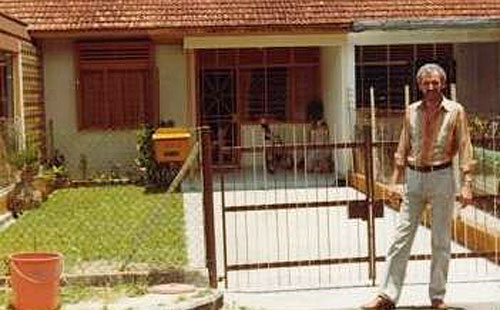
My old married quarters, taken on a visit
in 1983, my first time back since 1959
in 1983, my first time back since 1959
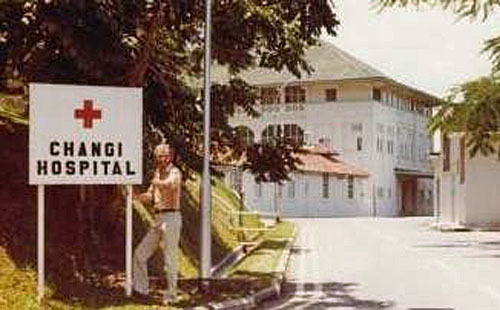
Photo taken in 1983 - bad memories!

From: Norman Stamper, 03184 Torrevieja
Subject: RAF Gan
Hi Tony,
Reference the documentary made by Anglia TV. As far as I can remember it was made in 1968.
Late in '68 I received my posting notice for Gan and remember before my departure Anglia TV aired the programme and advertised it in the TV Times, either late '68 or early '69.
As it was of great interest to me I kept a copy of the article (attached) and managed to get a copy of the programme several years later.
Regards
Norman
Subject: RAF Gan
Hi Tony,
Reference the documentary made by Anglia TV. As far as I can remember it was made in 1968.
Late in '68 I received my posting notice for Gan and remember before my departure Anglia TV aired the programme and advertised it in the TV Times, either late '68 or early '69.
As it was of great interest to me I kept a copy of the article (attached) and managed to get a copy of the programme several years later.
Regards
Norman

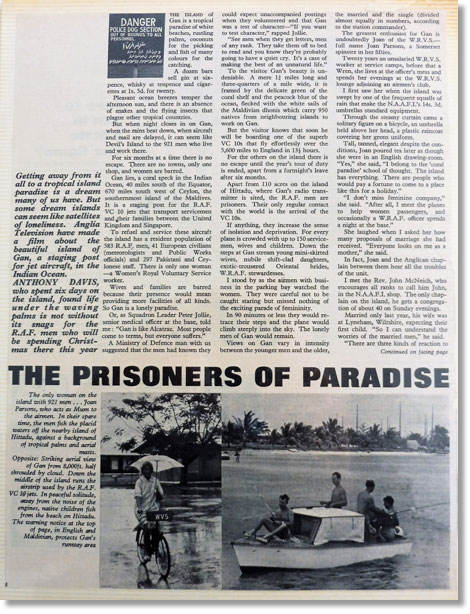
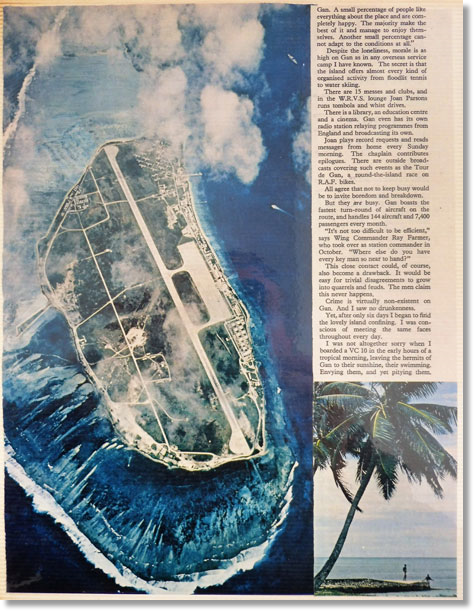
The Prisoners of Paradise
Gan lies, a coral speck in the Indian Ocean, 40 miles south of the Equator, 670 miles south west of Ceylon, the southernmost island of the Maldives. It is a staging post for the R.A.F. VC 10 jets that transport servicemen between the United Kingdom and Singapore.
To refuel and service these aircraft the island has a resident population of 583 R.A.F. men, 41 European civilians (meteorologists and Public Works officials) and 297 Pakistani and Ceylonese staff. There is only one woman - a Women's Royal Voluntary Service Worker.
Wives and families are barred because their presence would mean more facilities of all kinds. So Gan is a lonely paradise. Or, as Squadron Leader Peter Jollie, senior medical officer at the base, told me: "Gan is like Alcatraz. Most people come to terms, but everyone suffers"
A Ministry of Defence man with us suggested that the men had known they could expect unaccompanied postings when they volunteered and that Gan was a test of character - "If you want to test character," rapped Jollie. "See men when they get letters, men of any rank. They take them off to bed to read and you know they're probably going to have a quiet cry. It's a case of making the best of an unnatural life."
To the visitor Gan's beauty is undeniable. A mere 1¾ miles long and three-quarters of a mile wide, it is framed by the delicate green of the coral shelf and the peacock blue of the ocean, flecked with the white sails of the Maldivian dhonis which carry 950 natives from neighbouring islands to work on Gan.
To refuel and service these aircraft the island has a resident population of 583 R.A.F. men, 41 European civilians (meteorologists and Public Works officials) and 297 Pakistani and Ceylonese staff. There is only one woman - a Women's Royal Voluntary Service Worker.
Wives and families are barred because their presence would mean more facilities of all kinds. So Gan is a lonely paradise. Or, as Squadron Leader Peter Jollie, senior medical officer at the base, told me: "Gan is like Alcatraz. Most people come to terms, but everyone suffers"
A Ministry of Defence man with us suggested that the men had known they could expect unaccompanied postings when they volunteered and that Gan was a test of character - "If you want to test character," rapped Jollie. "See men when they get letters, men of any rank. They take them off to bed to read and you know they're probably going to have a quiet cry. It's a case of making the best of an unnatural life."
To the visitor Gan's beauty is undeniable. A mere 1¾ miles long and three-quarters of a mile wide, it is framed by the delicate green of the coral shelf and the peacock blue of the ocean, flecked with the white sails of the Maldivian dhonis which carry 950 natives from neighbouring islands to work on Gan.
Continued...
Continued...
But the visitor will know that soon he will be boarding one of the superb VC 10s that fly effortlessly over the 5,600 miles to England in 13½ hours. For the others on the island there is no escape until the year's tour of duty is ended, apart from a fortnight's leave after six months.
Apart from the 110 acres on the island of Hittadu, where Gan's radio transmitter is sited, the R.A.F. men are prisoners. Their only regular contact with the world is teh arrival of the VC 10s. If anything, they increase the sense of isolation. For every plane is crowded with up to 150 servicemen, wives and children. Down the steps at Gan stream young mini-skirted wives, nubile shift-clad daughters, exotic-trousered Oriental brides, W.R.A.F. stewardesses.
I stood by as the airmen with business in the parking lot watched the women. They were careful not to be caught staring but missed nothing of the exciting parade of femininity. In 90 minutes or less they would retrace their steps and the plane would climb steeply into the sky. The lonely men of Gan would remain. Views on Gan vary in intensity between the younger men and the older, the married and the single (divided almost equally in numbers, according to the station commander).
The greatest enthusiast for Gan is undoubtedley Joan of the W.R.V.S. - full name Joan Parsons, a Somerset spinster in her fifties. Twenty years an unsalaried W.R.V.S. worker at service camps, before that a Wren, she lives at the officer's mess and spends her evenings at the W.R.V.S. lounge adjoining an airmen's club.
I first saw her when the island was swept by one of the frequent squalls of rain that make the N.A.A.F.I.s 14s. 3d. umbrellas standard equipment. Through the steamy curtain came a solitary figure on a bicycle, an umbrella held above her head, plastic raincoat covering her green uniform.
Tall, tanned, elegant despite the conditions, Joan poured tea as though she were in a English drawing room. "Yes," she said, "I belong to the 'coral paradise' school of thought. The island has everything. There are people who would pay a fortune to come to a place like this for a holiday."
"I don't miss feminine company," she said, "After all, I meet the planes to help women passengers, and occasionally a W.R.A.F. officer spends a night at the base." She laughed when I asked how many proposals of marriage she had received. "Everyone looks on me as a mother," she said. In fact, Joan and the Anglican chaplain between them hear all the troubles of the unit.
Apart from the 110 acres on the island of Hittadu, where Gan's radio transmitter is sited, the R.A.F. men are prisoners. Their only regular contact with the world is teh arrival of the VC 10s. If anything, they increase the sense of isolation. For every plane is crowded with up to 150 servicemen, wives and children. Down the steps at Gan stream young mini-skirted wives, nubile shift-clad daughters, exotic-trousered Oriental brides, W.R.A.F. stewardesses.
I stood by as the airmen with business in the parking lot watched the women. They were careful not to be caught staring but missed nothing of the exciting parade of femininity. In 90 minutes or less they would retrace their steps and the plane would climb steeply into the sky. The lonely men of Gan would remain. Views on Gan vary in intensity between the younger men and the older, the married and the single (divided almost equally in numbers, according to the station commander).
The greatest enthusiast for Gan is undoubtedley Joan of the W.R.V.S. - full name Joan Parsons, a Somerset spinster in her fifties. Twenty years an unsalaried W.R.V.S. worker at service camps, before that a Wren, she lives at the officer's mess and spends her evenings at the W.R.V.S. lounge adjoining an airmen's club.
I first saw her when the island was swept by one of the frequent squalls of rain that make the N.A.A.F.I.s 14s. 3d. umbrellas standard equipment. Through the steamy curtain came a solitary figure on a bicycle, an umbrella held above her head, plastic raincoat covering her green uniform.
Tall, tanned, elegant despite the conditions, Joan poured tea as though she were in a English drawing room. "Yes," she said, "I belong to the 'coral paradise' school of thought. The island has everything. There are people who would pay a fortune to come to a place like this for a holiday."
"I don't miss feminine company," she said, "After all, I meet the planes to help women passengers, and occasionally a W.R.A.F. officer spends a night at the base." She laughed when I asked how many proposals of marriage she had received. "Everyone looks on me as a mother," she said. In fact, Joan and the Anglican chaplain between them hear all the troubles of the unit.
I met the Rev. John McNeich, who encourages all ranks to call him John, in the N.A.A.F.I. shop. The only chaplain on the island, he gets a congregation of about 40 on Sunday evenings. Married only last year, his wife was at Lyneham, Wiltshire, expecting their first child. "So I can understand the worries of the married men," he said. "There are three kinds of reaction to Gan. A small percentage of people like everything about the place and are completely happy. The majority make the best of it and manage to enjoy themselves. Another small percentage cannot adapt to the conditions at all."
Despite the loneliness, morale is as high on Gan as in any overseas service camp I have known. The secret is that the island offers almost every kind of organised activity from floodlit tennis to water skiing.
There are 15 messes and clubs, and in the W.R.V.S. lounge Joan Parsons runs tombola and whist drives. There is a library, and education centre and a cinema. Gan even has its own radio station relaying programmes from England and broadcasting its own.
Joan plays record requests and reads messages from home every Sunday morning. The chaplain contributes epilogues. There are outside broadcasts covering such events as teh Tour de Gan, a round-the-island on R.A.F. bikes.
All agree that not to keep busy would invite boredom and breakdown. But they are busy. Gan boasts the fastest turn-round of aircraft on the route, and handles 144 aircraft and 7,400 passengers every month. "It's not too difficult to be efficient," says Wing Commander Ray Farmer, who took over as station commander in October. "Where else do you have every key man so near to hand?"
This close contact could, of course, become a drawback. It would be easy for rivial disagreements to grow into quarrels and feuds. The men claim this never happens. Crime is virtually non-existent on Gan. And I saw no drunkenness. Yet, after only six days I began to find the lovely island confining. I was conscious of meeting the same faces throughout every day. I was not altogether sorry when I boarded a VC 10 in the early hours of a tropical morning, leaving the hermits of Gan to their sunshine, their swimming. Envying them, yet pitying them.
Despite the loneliness, morale is as high on Gan as in any overseas service camp I have known. The secret is that the island offers almost every kind of organised activity from floodlit tennis to water skiing.
There are 15 messes and clubs, and in the W.R.V.S. lounge Joan Parsons runs tombola and whist drives. There is a library, and education centre and a cinema. Gan even has its own radio station relaying programmes from England and broadcasting its own.
Joan plays record requests and reads messages from home every Sunday morning. The chaplain contributes epilogues. There are outside broadcasts covering such events as teh Tour de Gan, a round-the-island on R.A.F. bikes.
All agree that not to keep busy would invite boredom and breakdown. But they are busy. Gan boasts the fastest turn-round of aircraft on the route, and handles 144 aircraft and 7,400 passengers every month. "It's not too difficult to be efficient," says Wing Commander Ray Farmer, who took over as station commander in October. "Where else do you have every key man so near to hand?"
This close contact could, of course, become a drawback. It would be easy for rivial disagreements to grow into quarrels and feuds. The men claim this never happens. Crime is virtually non-existent on Gan. And I saw no drunkenness. Yet, after only six days I began to find the lovely island confining. I was conscious of meeting the same faces throughout every day. I was not altogether sorry when I boarded a VC 10 in the early hours of a tropical morning, leaving the hermits of Gan to their sunshine, their swimming. Envying them, yet pitying them.


Russian spy plane is given free rein to fly over the UK

An MoD spokesman told the Independent that UK military personnel will be “on board the Russian aircraft throughout the flight, ensuring compliance with treaty conditions.” He continued, “This is a completely routine visit which follows a UK over flight of Russia earlier this month.”
Signed in Helsinki, Finland in 1992, the Treaty on Open Skies came into force in 2002 and includes 34 signatory states. The observation flights are made over the US, Canada, Russia and Europe and are designed to enhance mutual understanding between states by helping participants gather information about foreign military forces.
This comes as relations between Putin’s Russia and western democracies are at their worst since the end of the Cold War.
The Irish Sun
Signed in Helsinki, Finland in 1992, the Treaty on Open Skies came into force in 2002 and includes 34 signatory states. The observation flights are made over the US, Canada, Russia and Europe and are designed to enhance mutual understanding between states by helping participants gather information about foreign military forces.
This comes as relations between Putin’s Russia and western democracies are at their worst since the end of the Cold War.
The Irish Sun

From: David King, Bury St Edmunds, Suffolk
Subject: Muharraq
Jon Guy’s memory of Execise Bersatu Padu reminsded me of an incident during this Exercise. Muharraq was first stopping point, refuelling etc., and one occasion, we had 90 pax from a C130 in our transit lounge. The Loadie came up to me grinning from ear-to-ear. On leaving the UK he had the Chalk Commander brief the pax to put their sweet papers into a pocket. On approaching Muharraq, no repeat briefing was given so sweet wrappers ended up on the floor! [For the uninitiated... hard boiled sweets are given out to passengers prior to take off and again prior to landing; the constant swallowing relieves painful ears when the aircraft changes pressurisation.]
Reading memories from past Muharraq Movers, does anyone remember the Indian Superconstellation that used to drop in to refuel? An oil filler cap was missing from an underwing oil filler point and had an old rag stuffed in to stop the oil leaking out. Unfortunately, it wasn’t successful and everyone in a 15 yard circle got sprayed with hot oil!
David King
Subject: Muharraq
Jon Guy’s memory of Execise Bersatu Padu reminsded me of an incident during this Exercise. Muharraq was first stopping point, refuelling etc., and one occasion, we had 90 pax from a C130 in our transit lounge. The Loadie came up to me grinning from ear-to-ear. On leaving the UK he had the Chalk Commander brief the pax to put their sweet papers into a pocket. On approaching Muharraq, no repeat briefing was given so sweet wrappers ended up on the floor! [For the uninitiated... hard boiled sweets are given out to passengers prior to take off and again prior to landing; the constant swallowing relieves painful ears when the aircraft changes pressurisation.]
Reading memories from past Muharraq Movers, does anyone remember the Indian Superconstellation that used to drop in to refuel? An oil filler cap was missing from an underwing oil filler point and had an old rag stuffed in to stop the oil leaking out. Unfortunately, it wasn’t successful and everyone in a 15 yard circle got sprayed with hot oil!
David King
A Russian spy plane was allowed to fly over the UK collecting information about the country’s military. But rather than being shot down, Vladimir Putin’s Antonov An-30B was welcomed into British airspace as part of the international Treaty on Open Skies.
Indeed, several British military officials will be on board the flight which has been pre-approved by the Ministry of Defence and Royal Air Force. The plane flew from RAF Brize Norton in Oxford and performed a number of observation flights.
Speaking with news agency TASS, Sergei Rhzhkov, head of Russia’s Nuclear Risk Reduction Centre said, “The observation flight will be performed in a period from May 15 to 19, 2017 from the Open Skies airdrome Brize Norton. The maximum range of the flight will be 2,400km.”
Indeed, several British military officials will be on board the flight which has been pre-approved by the Ministry of Defence and Royal Air Force. The plane flew from RAF Brize Norton in Oxford and performed a number of observation flights.
Speaking with news agency TASS, Sergei Rhzhkov, head of Russia’s Nuclear Risk Reduction Centre said, “The observation flight will be performed in a period from May 15 to 19, 2017 from the Open Skies airdrome Brize Norton. The maximum range of the flight will be 2,400km.”

From: Murdo Macleod, Newport-on-Tay, Fife
Subject: Newsletter OBB #042817
If Ascension's runway has potholes, then it didn't happen overnight, so why didn't the powers that be get it repaired? What is the world coming to when an important link to the Falklands goes down the pan, somebody get a grip and get it repaired! What a state we'd be in if we let that sort of thing happen to Brize, for instance, who's in charge of the menagerie these days?
I was reading about other guy's experiences in Muharraq and had a good laugh over them, but there were some lucky sods getting posted out there travelling on VC10's no less. I went home on one at the end of my time, but when I originally posted there they hadn't entered service. When they did come into service and they were being route tested, we had one come in being flown by a Group Captain no less, and the first time out he offered to take a full complement of lads home for the weekend, do a round-robin with them in the UK, and bring them all back on the Monday morning.
There were plenty of lads up for it, but the powers that be in Bahrain said that they would need to have the airfare back to Bahrain just in case something went wrong. The Groupie said that not even WW3 would prevent him from going back to Bahrain, it was all prearranged that the aircraft would fly the route, for at least three months, and that he could take lads home every weekend. Even if the aircraft he was using had a fault then he would fly a replacement, but his pleas fell on deaf ears, an opportunity missed. When he came back every Monday and Friday he didn't hesitate to take the piss out our deluded bosses, and called them everything under the sun.
He used to say to us, that he couldn't understand how we could work for such prats, I really liked that guy, we had some really good senior officers, and some real clowns, stories still to tell...
Murdo Macleod
Subject: Newsletter OBB #042817
If Ascension's runway has potholes, then it didn't happen overnight, so why didn't the powers that be get it repaired? What is the world coming to when an important link to the Falklands goes down the pan, somebody get a grip and get it repaired! What a state we'd be in if we let that sort of thing happen to Brize, for instance, who's in charge of the menagerie these days?
I was reading about other guy's experiences in Muharraq and had a good laugh over them, but there were some lucky sods getting posted out there travelling on VC10's no less. I went home on one at the end of my time, but when I originally posted there they hadn't entered service. When they did come into service and they were being route tested, we had one come in being flown by a Group Captain no less, and the first time out he offered to take a full complement of lads home for the weekend, do a round-robin with them in the UK, and bring them all back on the Monday morning.
There were plenty of lads up for it, but the powers that be in Bahrain said that they would need to have the airfare back to Bahrain just in case something went wrong. The Groupie said that not even WW3 would prevent him from going back to Bahrain, it was all prearranged that the aircraft would fly the route, for at least three months, and that he could take lads home every weekend. Even if the aircraft he was using had a fault then he would fly a replacement, but his pleas fell on deaf ears, an opportunity missed. When he came back every Monday and Friday he didn't hesitate to take the piss out our deluded bosses, and called them everything under the sun.
He used to say to us, that he couldn't understand how we could work for such prats, I really liked that guy, we had some really good senior officers, and some real clowns, stories still to tell...
Murdo Macleod

Brazil states RAF Hercules flights from or to Falklands are “humanitarian motivated”
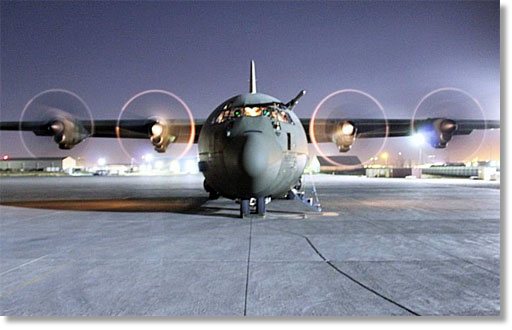
The Brazilian government discards any “irregularities” in allowing British military aircraft, flying to or from the Falkland Islands, landing in its airports since the authorizations are humanitarian motivated, revealed a source from the Brazilian government to the Argentine news agency, Telam. “Brazil accepts the landing of aircraft for humanitarian motives. The Hercules from the RAF are catalogued that way, since they are internationally recognized as search and rescue, SAR” added the source from the government of president Michel Temer.
The Brazilian foreign ministry, better known as Itamaraty Palace said that Brasilia's official position is not to comment the episode, and a spokesperson from the Defense ministry reiterated that who is responsible for collecting data on those flights is the Brazilian Air Force. Argentina expressed its concern to Brazil at the beginning of the year and the foreign minister Susana Malcorra recalled there is an agreement between South American countries, in solidarity with Argentina's sovereignty claim over the Islands, to impede the landing of aircraft heading for or coming from the Falklands.
The Brazilian foreign ministry, better known as Itamaraty Palace said that Brasilia's official position is not to comment the episode, and a spokesperson from the Defense ministry reiterated that who is responsible for collecting data on those flights is the Brazilian Air Force. Argentina expressed its concern to Brazil at the beginning of the year and the foreign minister Susana Malcorra recalled there is an agreement between South American countries, in solidarity with Argentina's sovereignty claim over the Islands, to impede the landing of aircraft heading for or coming from the Falklands.
According to the Brazilian government spokesperson, Brazil does not allow the British transport by air or sea of troops or military provisions to or from the Islands. The three conditions under which Brazil accepts exceptionally UK military flights which are heading to or coming from the Falklands are: humanitarian emergency situations, (which include the support and maintenance of SAR equipment which the British have in the Islands); air emergency, and medical emergency situations.
According to Argentine sources so far this year four RAF Hercules flights have landed in Brazil for fuelling: two in Porto Alegre, Salgado Filho terminal, and two in Sao Paulo, Guarulhos international airport. The spokesperson added that “since mid XIX century, when Brazil was an empire, it has recognized the Malvinas Islands are Argentine”. Furthermore “contacts between Brazil and Argentina are frequent, and the issue can be addressed at different levels”.
The Brazilian government source added that in 2015, under removed Brazilian president Dilma Rousseff the number of these flights totaled 15, while during 2016, under the new administration they were down to half.
“Under the previous government as with this government, the Brazilian position has been in accordance with the same humanitarian motives, taking into account that the Hercules aircraft are recognized internationally as search and rescue”, pointed out the spokesperson.
Additionally “Brazil has had contacts through different diplomatic channels with Argentine authorities in the last few months to address the issue. In those meetings Brazilian diplomats have explained that the position of Brazil in not accepting regular British flights to and from the Islands is voluntary and unilateral, based in the historic support of Brazil to Argentine sovereignty right over the Malvinas Islands.”
MercoPress.
According to Argentine sources so far this year four RAF Hercules flights have landed in Brazil for fuelling: two in Porto Alegre, Salgado Filho terminal, and two in Sao Paulo, Guarulhos international airport. The spokesperson added that “since mid XIX century, when Brazil was an empire, it has recognized the Malvinas Islands are Argentine”. Furthermore “contacts between Brazil and Argentina are frequent, and the issue can be addressed at different levels”.
The Brazilian government source added that in 2015, under removed Brazilian president Dilma Rousseff the number of these flights totaled 15, while during 2016, under the new administration they were down to half.
“Under the previous government as with this government, the Brazilian position has been in accordance with the same humanitarian motives, taking into account that the Hercules aircraft are recognized internationally as search and rescue”, pointed out the spokesperson.
Additionally “Brazil has had contacts through different diplomatic channels with Argentine authorities in the last few months to address the issue. In those meetings Brazilian diplomats have explained that the position of Brazil in not accepting regular British flights to and from the Islands is voluntary and unilateral, based in the historic support of Brazil to Argentine sovereignty right over the Malvinas Islands.”
MercoPress.

From: Andrew Kay, Colorado Springs, CO
Subject: Two-SIx
Hi Tony and greetings from Colorado where it can't decide if it's spring or winter judging by the snowfall we had last weekend.
I read Gordon Gray's piece on the habit of movers to yell Two-Six when shifting something heavy, and I was told in the old Air Movements Training School that it originated with the firing of cannons in the Royal Navy and was something the numbers two and six yelled when pulling the cannons after (or maybe before) they had been fired.
Who was I to argue with the training staff? After all I was just an AC at the time and they were Gods to us, so I have always accepted this as the "true" story. However Wikipedia now informs me that it was just some b.s.story they dreamed up in their coffee lounge and now all these years later I should treat it with as much disdain as the stories the sergeant in the recruiting office told me when I went in to take the oath.
So I am hoping someone on here can give us the actual reason two-six is yelled, although if it comes from an ex-member of the AMTS or RAFMS training staff I would pretty much treat it as one more of their Jackanory stories. :-)
Cheers!
Andy Kay
Subject: Two-SIx
Hi Tony and greetings from Colorado where it can't decide if it's spring or winter judging by the snowfall we had last weekend.
I read Gordon Gray's piece on the habit of movers to yell Two-Six when shifting something heavy, and I was told in the old Air Movements Training School that it originated with the firing of cannons in the Royal Navy and was something the numbers two and six yelled when pulling the cannons after (or maybe before) they had been fired.
Who was I to argue with the training staff? After all I was just an AC at the time and they were Gods to us, so I have always accepted this as the "true" story. However Wikipedia now informs me that it was just some b.s.story they dreamed up in their coffee lounge and now all these years later I should treat it with as much disdain as the stories the sergeant in the recruiting office told me when I went in to take the oath.
So I am hoping someone on here can give us the actual reason two-six is yelled, although if it comes from an ex-member of the AMTS or RAFMS training staff I would pretty much treat it as one more of their Jackanory stories. :-)
Cheers!
Andy Kay
From: Tony Gale, Gatineau, QC
Subject: RE: Two-SIx
Hi Andy,
The weather in Quebec is miserable right now too – temperatures in the low single digits and raining. By coincidence I had a binge weekend watching Hornblower – 8 x 2 hour movies about the Royal Navy set in the period up to and including the start of the Napoleonic War.
There were countless times that the rolling up of the guns was portrayed and not once did I hear the 'two-six' shouted. However, in Episode #7 – Loyalty - when Horatio and some of his crew were escaping from the make-shift prison in Brest, they were using a block and tackle set-up to free themselves from their shackles and 'two-six' was used a couple of times.
Best regards
Tony
Subject: RE: Two-SIx
Hi Andy,
The weather in Quebec is miserable right now too – temperatures in the low single digits and raining. By coincidence I had a binge weekend watching Hornblower – 8 x 2 hour movies about the Royal Navy set in the period up to and including the start of the Napoleonic War.
There were countless times that the rolling up of the guns was portrayed and not once did I hear the 'two-six' shouted. However, in Episode #7 – Loyalty - when Horatio and some of his crew were escaping from the make-shift prison in Brest, they were using a block and tackle set-up to free themselves from their shackles and 'two-six' was used a couple of times.
Best regards
Tony


Resupply mission to Alert falls short as stubborn fog prevents RCAF transports from landing
Operation Boxtop, the Royal Canadian Air Force’s semi-annual re-supply mission to the world’s northernmost community, hit a snag earlier this month— fog kept RCAF planes from landing and left the site with one-third of the fuel expected. On April 20, a CC-150 airbus departed from Trenton with a team ready to deliver 1.5 million litres of low-sulphuric and jet fuel to Canadian Forces Station Alert, Nunavut — the Earth’s most northern base.
"Alert is a listening post for picking up radio frequencies from Moscow and wherever else,” says David Gray, a former resident and author of Alert: beyond the Inuit Lands, as well as an important hub for climate and ecological research. But, 800 kilometres from the North Pole and 2,000 kilometres from the nearest grocery store, sustaining Alert is neither easy nor cheap.
Since 1956, the RCAF has been moving supplies to the base via military plane. This involves massive, annual shipments of fuel — usually in spring — and of dry goods including rations, construction and research materials and the like — in autumn.
"Alert is a listening post for picking up radio frequencies from Moscow and wherever else,” says David Gray, a former resident and author of Alert: beyond the Inuit Lands, as well as an important hub for climate and ecological research. But, 800 kilometres from the North Pole and 2,000 kilometres from the nearest grocery store, sustaining Alert is neither easy nor cheap.
Since 1956, the RCAF has been moving supplies to the base via military plane. This involves massive, annual shipments of fuel — usually in spring — and of dry goods including rations, construction and research materials and the like — in autumn.
Most of the year, the RCAF says, blowing snow and frequent and, in some seasons, constant darkness “reduce visibility to zero.” This makes sending planes to deliver goods a non-starter. That’s why both re-supply operations run in the narrow window when the temperature of Ellesmere Island rises to a balmy -15 degrees Celsius and the sun doesn’t go down. These spring and autumn delivery dates are supposed to make for easy landing and a smooth process overall. Not this time.
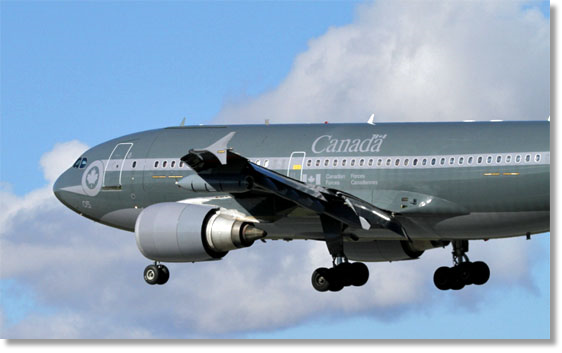
The main body of the 98-person team arrived at the Thule air base in Greenland on April 23, RCAF major Josh Leveque says. Though Greenland’s weather was cooperative, he’d been told in advance Alert was foggy.
When the first fuel planes arrived the following day, “you could see almost all of Alert, except the runway, which was covered in fog,” Leveque says. Dampness, water on the ground and a fierce wind from the Pacific created a “freezing fog on the runway” that made landing very difficult. Still, meteorologists at Alert told the RCAF the wind would change direction, opening the runway for safer landing. “I don’t want to throw Alert’s weather guys under the bus but they told us they expected a change in the wind. It didn’t change,” Leveque says. Though, in Alert’s defence, he says, “civilian weather forecasts get things wrong all the time.” Though the RCAF made its deliveries, with some difficulty, on the first day, “after that, it was very sporadic,” Leveque says. After April 24, plane after plane flew within landing distance of Alert but, without a clear path, they hung in the air until fuel became a concern and they were instructed to return.
From April 24 and May 5, the RCAF planned to deliver four C-17s and two Hercules military planes full of fuel to Alert each day. It planned a total of 30 drop-offs to reach its target. Eventually, it became clear Alert’s initial forecast was wrong and the cloud ceiling was not going to rise. “Based on how the later forecasts looked, we cancelled the next deliveries,” Leveque says.
When the first fuel planes arrived the following day, “you could see almost all of Alert, except the runway, which was covered in fog,” Leveque says. Dampness, water on the ground and a fierce wind from the Pacific created a “freezing fog on the runway” that made landing very difficult. Still, meteorologists at Alert told the RCAF the wind would change direction, opening the runway for safer landing. “I don’t want to throw Alert’s weather guys under the bus but they told us they expected a change in the wind. It didn’t change,” Leveque says. Though, in Alert’s defence, he says, “civilian weather forecasts get things wrong all the time.” Though the RCAF made its deliveries, with some difficulty, on the first day, “after that, it was very sporadic,” Leveque says. After April 24, plane after plane flew within landing distance of Alert but, without a clear path, they hung in the air until fuel became a concern and they were instructed to return.
From April 24 and May 5, the RCAF planned to deliver four C-17s and two Hercules military planes full of fuel to Alert each day. It planned a total of 30 drop-offs to reach its target. Eventually, it became clear Alert’s initial forecast was wrong and the cloud ceiling was not going to rise. “Based on how the later forecasts looked, we cancelled the next deliveries,” Leveque says.
On May 6, the team tasked with delivering fuel to sustain Alert for the year returned to Trenton. A total 561, 700 litres of fuel had been delivered to the base. That’s a little more than one third of the 1.5-million litre target. Aside from the maintenance and weather problems, the operation went smoothly.
Alert’s 62 residents will have to wait until October, during the second Boxtop re-supply, to receive the rest of the planned fuel. Leveque says the RCAF will combine the usual “dry lift,” with extra fuel in the planes’ wings to support the site. Should the October re-supply fall through, Leveque says the RCAF is “confident Alert has enough fuel in storage to last until January.”
This isn’t the first time Operation Boxtop has fallen short. Back in October 1991, Boxtop flight 22 missed Alert’s runway and crashed, killing five. The weather was so hostile that the rescue plane sent after it was unable to land, leaving the survivors, soaked in diesel fuel, freezing in Nunavut snow for hours, the RCAF says.
Comparatively, Leveque says of the most recent re-supply: “aside from the maintenance and weather problems, the operation went smoothly.”
Difficulties aside, Gray says “most would not like to see Alert closed, even if it becomes out of date and not very useful from a military intelligence point of view, because it is the most northern point on Earth.”
National Post
Alert’s 62 residents will have to wait until October, during the second Boxtop re-supply, to receive the rest of the planned fuel. Leveque says the RCAF will combine the usual “dry lift,” with extra fuel in the planes’ wings to support the site. Should the October re-supply fall through, Leveque says the RCAF is “confident Alert has enough fuel in storage to last until January.”
This isn’t the first time Operation Boxtop has fallen short. Back in October 1991, Boxtop flight 22 missed Alert’s runway and crashed, killing five. The weather was so hostile that the rescue plane sent after it was unable to land, leaving the survivors, soaked in diesel fuel, freezing in Nunavut snow for hours, the RCAF says.
Comparatively, Leveque says of the most recent re-supply: “aside from the maintenance and weather problems, the operation went smoothly.”
Difficulties aside, Gray says “most would not like to see Alert closed, even if it becomes out of date and not very useful from a military intelligence point of view, because it is the most northern point on Earth.”
National Post

Memories of RAF Changi
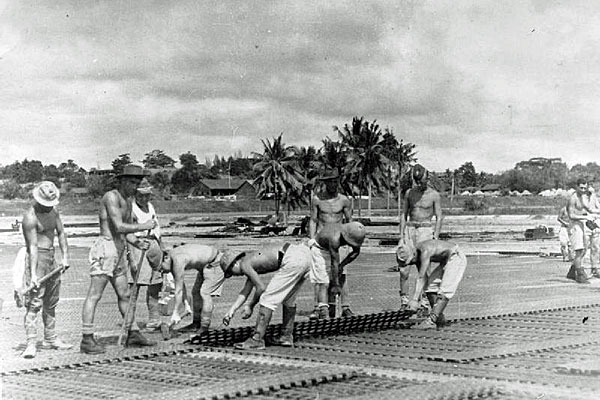
RAF 5353 Airfield Construction Wing and Japanese
POWs improving runway of RAF Changi in 1946
POWs improving runway of RAF Changi in 1946
First completed as a British artillery camp in 1940, it was used together with the nearby Changi Prison for housing many of the Allied prisoners-of-war (POWs) after the fall of Singapore in 1942.
The construction of the airfield was initiated by the occupying Imperial Japanese forces using those same Allied POWs as forced labourers, building two unpaved landing strips between 1943 and 1944, intersecting in a cross layout and in approximately north-south and east-west directions.
The airfield facility became a Royal Air Force station and was renamed RAF Changi in 1946 after the Japanese surrender.
Imprisoned Japanese troops were then made to improve the runways, reinforcing the north-south runway for military aircraft and adding perforated steel plates to the east-west runway.
Completed post war, RAF Chia Keng — a GCHQ radio receiving station, was a satellite station of RAF Changi (being the Headquarters Air component part of British Far East Command) until the British Forces withdrawal from Singapore.
The construction of the airfield was initiated by the occupying Imperial Japanese forces using those same Allied POWs as forced labourers, building two unpaved landing strips between 1943 and 1944, intersecting in a cross layout and in approximately north-south and east-west directions.
The airfield facility became a Royal Air Force station and was renamed RAF Changi in 1946 after the Japanese surrender.
Imprisoned Japanese troops were then made to improve the runways, reinforcing the north-south runway for military aircraft and adding perforated steel plates to the east-west runway.
Completed post war, RAF Chia Keng — a GCHQ radio receiving station, was a satellite station of RAF Changi (being the Headquarters Air component part of British Far East Command) until the British Forces withdrawal from Singapore.
Also, the nearby RAF Hospital Changi, Old Changi Hospital (now defunct as Changi Hospital) functioned as the primary British military hospital providing medical care for all British, Australian and New Zealand servicemen stationed in the Eastern and Northern part of Singapore, while Alexandra Hospital was put in charge for those stationed in the Southern and Western part of Singapore.
Changi Air Base.
Upon the withdrawal of British forces from Singapore, RAF Changi was renamed as Changi Air Base (CAB) and was handed over to the SADC (predecessor of Republic of Singapore Air Force) on 9 Dec 1971.
In June 1975, the Singapore government acquired about two-thirds of the airbase (save for the main flight-line, hangar/aircraft maintenance facilities and control tower which were located in the western section of the airbase) for the construction of the new Singapore Changi Airport, with the new runways in close alignment with the original north-south runway. The east-west runway was almost erased from the map, currently surviving as a taxiway to the apron area which has remained operational as part of Changi Air Base.
For a more in-depth look at the early days see the article here: http://ukmamsoba.org/raf_changi.html
Changi Air Base.
Upon the withdrawal of British forces from Singapore, RAF Changi was renamed as Changi Air Base (CAB) and was handed over to the SADC (predecessor of Republic of Singapore Air Force) on 9 Dec 1971.
In June 1975, the Singapore government acquired about two-thirds of the airbase (save for the main flight-line, hangar/aircraft maintenance facilities and control tower which were located in the western section of the airbase) for the construction of the new Singapore Changi Airport, with the new runways in close alignment with the original north-south runway. The east-west runway was almost erased from the map, currently surviving as a taxiway to the apron area which has remained operational as part of Changi Air Base.
For a more in-depth look at the early days see the article here: http://ukmamsoba.org/raf_changi.html

From: Tony Mullen, Toowoomba, QLD 4350
Subject: Memories of Changi
Subject: Memories of Changi
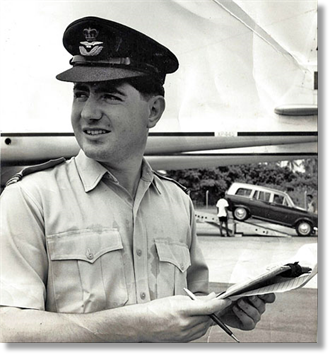
In June 1963, three Pilot Officers straight off the equipment and movements courses were posted to Changi Air Movements; myself, Paul Crotty (later Air Cdre) and the lovely Virginia Latimer-Allen. Ginny immediately found a niche as Pax officer and Paul and I were tasked to run the Paya Lebar detachment on a 24 hr on and 24 hr off basis. At that time Changi runways were being upgraded and the Comets and Brittanias from Lyneham plus UK charter flights were being handled at Paya Lebar International airport. It was quite a cruisy job to begin with. If there were no movements scheduled then we could remain on call at Changi, normally at the swimming pool!
Then a new SAMO arrived, Roy Mills, now deceased. Up until then we had grabbed staff as required from the duty Changi shift to meet requirements at Paya Lebar. Roy managed to obtain more NCOs and airmen on detachment from UK and they were allocated to Paul and I on a permanent basis. Most were from supply squadrons with very limited movements experience. Most had only attended the Movements course and then returned to supply duties.
Then a new SAMO arrived, Roy Mills, now deceased. Up until then we had grabbed staff as required from the duty Changi shift to meet requirements at Paya Lebar. Roy managed to obtain more NCOs and airmen on detachment from UK and they were allocated to Paul and I on a permanent basis. Most were from supply squadrons with very limited movements experience. Most had only attended the Movements course and then returned to supply duties.
I was given my new team and to my horror the first task was a Comet casevac turnround from pax to casevac and return to UK. The Comet was notoriously nose heavy and difficult to trim. In the Casevac role it was even worse! I was expected to manage it with my new team with no training and no induction of any sort. I pleaded with Roy Mills to give me a couple of experienced staff to guide us through this first challenge. My request was refused!
Well it was a debacle. The turnround was one and a half hours longer than scheduled. I finished up doing the trim sheet because no one else knew how to and we finished up overweight and I had to offload 2 Gan pax to get it under max all up weight. Furthermore, we had a route report from the Comet captain and an official complaint from the Group Captain medic who was furious about his patients waiting in ambulances on the tarmac for over an hour. It was a nightmare but I give Roy Mills his due, he apologised to me later and said he should not have left me in that situation.
All went well after that until my 20th birthday on Dec 13th 1963. There was a lull in movements at Paya Lebar. The only scheduled arrival was a UK charter due in early am on 14th. Then joy of joys we received notification that it had become U/S on route and there was a 24 hr delay. Paul and I decided to celebrate my birthday with a trip to Singapore city. It was quite a night and after many Tiger beers and visits to various dubious locations we somehow finished up drinking scotch in the engine room of a freighter in Singapore Harbour with the Scottish Chief Engineer. We staggered back to Changi as dawn was breaking and crashed out. We were shortly awoken by an Air Movements MT Driver who advised us that the SAMO wanted to see us immediately.
The charter flight had been repaired and arrived as originally scheduled! No one to meet it until the Changi DAMO rushed across to Paya Lebar to placate the passengers! Roy Mills was furious and Paul and I were punished by being directed to be on duty every day regardless of Paya Lebar movements. If not at Paya Lebar we were to report to the Changi DAMO and assist him. We were not allowed in the bar at the mess and only allowed in the mess to eat and sleep. We were told we were lucky we were not Court Martialled! This went on for a month at least. Interesting times indeed!
I transferred to MAMS three months later and of interest one of my detachments was to Gan to relieve the SAMO for a month whilst he was on compassionate leave. That was a very enjoyable time. Swimming in the lagoon and deep sea fishing off the stern of the Air Sea recue launch at full speed. During my time there we had a Comet engine change which entailed the passengers remaining on the Island for 48 hrs. One of the females was a beautiful blonde who was the relative of some Army General. I tried desperately to seduce her including trips around the island in the Movement Landrover to secluded spots. Unfortunately my efforts failed miserably! The detachment finished with a memorable flight back to Singapore at low level in a 205 Sqn Shackleton which, for the benefit of some of the younger readers, was similar to a Lancaster.
Happy memories from a long time ago. Keep up the good work Tony. I really enjoy the monthly piece of nostalgia.
Tony Mullen
Tony Mullen


From: Charles Gibson, Monifieth, Angus
Subject: Memories of RAF Changi
January 1965 I was in Changi Transit waiting to go to Kuching (Borneo). There were monkeys who used to come into the showers during the night and they were quite dangerous.
The only we time came across permanent staff were WRAFs at the camp dance and once they found out we were from Borneo they lost total interest in us.
Chas 43rd
Subject: Memories of RAF Changi
January 1965 I was in Changi Transit waiting to go to Kuching (Borneo). There were monkeys who used to come into the showers during the night and they were quite dangerous.
The only we time came across permanent staff were WRAFs at the camp dance and once they found out we were from Borneo they lost total interest in us.
Chas 43rd

From: David Stevens, Bangor
Subject: Memories of RAF Changi
Hi Tony,
My own memories of Changi are limited to those of a transiting passenger. It must have been a 'dream' posting.
The only thing that sticks in my mind, apart from the fact that it was a huge air base, were the humungous monsoon drains. After one particularly heavy monsoon downpour I understood why they were so big! This was about 1964 to 1966.
Kind regards
David
Subject: Memories of RAF Changi
Hi Tony,
My own memories of Changi are limited to those of a transiting passenger. It must have been a 'dream' posting.
The only thing that sticks in my mind, apart from the fact that it was a huge air base, were the humungous monsoon drains. After one particularly heavy monsoon downpour I understood why they were so big! This was about 1964 to 1966.
Kind regards
David

From: Charles Collier, Ewhurst, Surrey
Subject: RAF Changi Singapore
Back in 1971, on completion of the Air Movements Course, I was on a holding attachment at RAF Abingdon, being the last SAMO, with P/O Peter Dingwell and F/O Earnest Arulandam as DAMOs. The essential part of this appointment was that I was to be posted to RAF Changi as a DAMO. There was a month for me to prepare myself. I thought this was adequate but unbeknown by me at the time this proved very short and required some fast thinking to keep up with the events that were to unfold.
Subject: RAF Changi Singapore
Back in 1971, on completion of the Air Movements Course, I was on a holding attachment at RAF Abingdon, being the last SAMO, with P/O Peter Dingwell and F/O Earnest Arulandam as DAMOs. The essential part of this appointment was that I was to be posted to RAF Changi as a DAMO. There was a month for me to prepare myself. I thought this was adequate but unbeknown by me at the time this proved very short and required some fast thinking to keep up with the events that were to unfold.
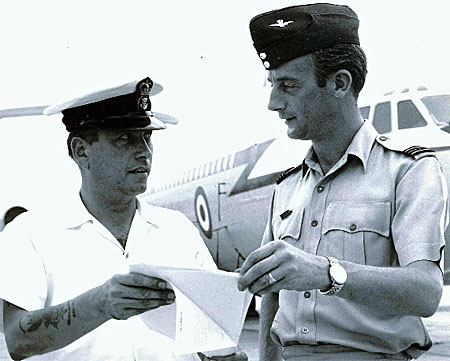
It happened that I met the girl of my dreams, Elaine, a nurse with the Princess Mary's Royal Air Force Nursing Service (PMRAFNS). I found out that her parents were at RAF Laabruch where her father was the station padre. I ventured over to see them and explain who I was and that my posting to Singapore was imminent. Elaine's father mentioned a wedding at Laarbruch and he subsequently made all of the arrangements.
I took up my posting as DAMO RAF Changi, but returned to Laarbruch a month later where Elaine and I were married. We both returned to Singapore and found some accommodations at the Crescent Flats in Katong. Life was rich in terms of where we were. Singapore was probably the best overseas posting the RAF was bestowed with. Besides all the joys of Singapore island itself, we were able to drive across the bridge at Johore Baroo into Malaysia.
It was also possible to obtain indulgence flights to Australia and New Zealand and with so much traffic at that time, return was never a problem! More is the pity that all this is no more for the modern RAF. Singapore was the best honeymoon anyone could wish for!
All the best everybody.
Charles
I took up my posting as DAMO RAF Changi, but returned to Laarbruch a month later where Elaine and I were married. We both returned to Singapore and found some accommodations at the Crescent Flats in Katong. Life was rich in terms of where we were. Singapore was probably the best overseas posting the RAF was bestowed with. Besides all the joys of Singapore island itself, we were able to drive across the bridge at Johore Baroo into Malaysia.
It was also possible to obtain indulgence flights to Australia and New Zealand and with so much traffic at that time, return was never a problem! More is the pity that all this is no more for the modern RAF. Singapore was the best honeymoon anyone could wish for!
All the best everybody.
Charles
From: Jim Aitken, Sunshine Coast QLD
Subject: Memories of RAF Changi
My introduction to service in the Far East Air Force at Changi, in the middle of 1958, was by way of the good old fashioned troopship. We must have been close to the last of the British troops to be ferried overseas by boat. The "Empire Windrush" had gone up in flames, and, apart from the "Oxfordshire" the only other name that comes to mind is the "Dunera". There may have been others, but the days of the troopship were fast disappearing. Embarkation was at Southampton and the 'troops' were a mix of all services and families. The voyage took us via Gibraltar, Suez, Aden, Colombo, through the Malacca Straights and into Singapore Harbour. In all it took about four weeks to get there.
Subject: Memories of RAF Changi
My introduction to service in the Far East Air Force at Changi, in the middle of 1958, was by way of the good old fashioned troopship. We must have been close to the last of the British troops to be ferried overseas by boat. The "Empire Windrush" had gone up in flames, and, apart from the "Oxfordshire" the only other name that comes to mind is the "Dunera". There may have been others, but the days of the troopship were fast disappearing. Embarkation was at Southampton and the 'troops' were a mix of all services and families. The voyage took us via Gibraltar, Suez, Aden, Colombo, through the Malacca Straights and into Singapore Harbour. In all it took about four weeks to get there.
Bussing to Changi from the docks was an experience as we travelled along the East Coast Road past all of the shop-houses and kampongs where the majority of the local people lived. As we came up to Changi, our escort pointed out the walled prison set back from the road where so many Japanese atrocities had taken place only a handful of years before.
The area between Changi airfield and Singapore City was largely undeveloped up to the outskirts of the city. The prison appeared to be set in a large field about 100 metres from the main road. The high perimeter walls were all newly painted white. As we approached the RAF Station, we were shown the two-story barrack blocks which had also served as prison accommodation for the British and Allied forces caught in Singapore when it fell to the Japanese. I had previously stayed over in these on the last visit to Singapore but had not then realized the significance of them.
Some of the blocks had a very sad background. Probably the worst being where the female nurses were thrown off the upper verandahs and killed for some minor infraction. Ronald Searle, the artist/cartoonist, was held in one building, and painted a mural on the walls using blood as a pigment. After repeated white-washing, the mural (of a religious nature), was rumoured to keep reappearing through the paint - a bit spooky!
I was allocated a billet in one of these blocks. There was an elderly Chinese lady we called 'Sew Sew' who used to call around all the single men's billets. She would offer to do any sewing or repairs for a few cents. Inside her blouse she had a medal which was reputed to be a George Medal which had been awarded to her husband who had smuggled food into Changi Prison during the Japanese occupation. Sew Sew was a wonderful old lady and I wonder if any others remember her.
It was time to report for work and be told where I was going to be placed. As usual, the first job was on the loading party. As a corporal, my job was to direct a group of local 'coolies' as they were referred to in the loading of aircraft. Because of the climate, it was not considered right for us airmen to be doing menial tasks such as loading, and this was reserved for the coolies.
Well, first day and off I go with a bunch of local Chinese and Malay workers down to the lines where the aircraft are parked awaiting loading. A truck full of freight and a fork lift appear, and I begin to give my orders as to how the aircraft should be loaded. I was very explicit, and talked very slowly to make sure they understood what I was saying. They appeared to be listenening very attentively, although by the lack of response I was wondering if they understood English at all! When I had finished they sort of looked at me, then at each other, and began to load the aircraft. They did not use any of my suggested tactics and went about their business totally ignoring me. When the aircraft was finished and the loading plan handed in to the weight and balance people in Load Control, the result was that the aircraft was in perfect flight trim. The look of amusement on the faces of my gang said it all. They had been loading these aircraft for such a long time that it became second nature to them and my inclusion on their team was merely as an RAF representative. Thankfully, very shortly after that, I was moved to passenger handling at Changi Creek which was the transit hotel for personnel arriving and departing, or merely passing through.
I had married before being posted to Singapore, and, as our firstborn was due soon, I was in a hurry to get my wife out to join me . She travelled out by a Hermes aircraft operated by Skyways of London. We initially had a flat, but when a new estate of terraced bungalows was nearing completion, we grabbed one of them and, although they had an Asian toilet set-up (aka 'a hole in the floor'), they were approved on the proviso that proper toilets were to be fitted later when the sewage system was completed. The house was opposite a Chinese burial ground of some proportions and quite often we witnessed (and heard) the celebrations as the deceased were laid to rest.
In 1958-59 there was a lot of increased activity with through flights to Australia. During this time the Atomic Weapons and rocket testing trials were taking place at Woomera and Maralinga. My duty was a 24 on - 48 off routine, which was great because as soon as things quietened down of an evening it was possible to grab a bed at the hotel and get a good nights sleep. However, with the increased activity in Australia, it was getting near impossible to get any sleep, and things got even more hectic. I was getting pretty run down by now, and whether that was a contributing factor I'll never know, but my career in Singapore came to an end when I contracted Polio. After a period of intense quarantine at Changi Hospital, it was decided to casevac me on the next available flight to the UK. My boss at the Passenger section was a Flt Lt Myer, and he was a great help to my wife in preparing for a hasty return to the UK. There was also a Flying Officer, whose name eludes me, who contracted meningitis just after me going down with polio and it was feared at first that he had the dreaded disease also. It was a bad year for polio worldwide. And so, from being a Mover I suddenly became a Movee! I was casevac'd back to the UK via a Comet 2 and landed in (where else?) Lyneham! From there to I went to Wroughton Hospital and eventually to the Medical Rehabilitation Unit in Chessington, where I spent the best part of a year.
We saw the first Comet belonging to BOAC, but on RAF charter, land at Paya Leba, which was then the civilian airfield in Singapore. It was only a short distance from Changi, but all civil aircraft, even if on charter to the RAF, always landed at Paya Leba. I remember the passenger terminal was the size of a large shed and just as salubrious! I recall that the Comet was doing tropical proving trials before acceptance into the RAF Transport Command fleet.
In 2002 my wife and I vacationed in Singapore and Malaysia for two weeks. I can report that Malaysia is going ahead in leaps and bounds.
Everywhere there are signs of affluence and the economy is rapidly moving from the old rural style based on rubber, tin and coconuts, to one based on manufacturing and hi-tech industry. Tourism is also being marketed, and some fine hotels and resorts are all over the place.
Everywhere there are signs of affluence and the economy is rapidly moving from the old rural style based on rubber, tin and coconuts, to one based on manufacturing and hi-tech industry. Tourism is also being marketed, and some fine hotels and resorts are all over the place.
Singapore, to us, had lost some of its oriental flavour. Highrise buildings abound. The East Coast Parkway, a multilane motorway, links the city to Changi International Airport. Kampongs have completely disappeared and the population seem to all live in highrise blocks of flats.
As my wife and I came alongside Changi Prison in our taxi we were both "gob-smacked" to see that a Japanese school had been built directly opposite the prison on the main road. How insensitive would that be. At least they could have waited till all the old 'diggers' had passed away before pulling a stunt like that!
As my wife and I came alongside Changi Prison in our taxi we were both "gob-smacked" to see that a Japanese school had been built directly opposite the prison on the main road. How insensitive would that be. At least they could have waited till all the old 'diggers' had passed away before pulling a stunt like that!
Raffles Hotel is timeless of course, and has been added to, but done very sympathetically to maintain the heritage of the era - Noel Coward would be pleased. In my day, Raffles was ‘out of bounds’ to other ranks, and it was great to be able to order a Singapore Sling at the Long Bar after all these years. The Britannia Club, the other rank's club in Singapore which is across the road from Raffles, is still there. It now serves as the other rank's club for the Singapore Defence Force. Visitors are welcomed and they maintain a guest book . It was amazing to see the entries from all the ex-service people who had made the trip back and taken the time to visit the club again.

From: Bernie Hurdsfield, Corby, Northants
Subject: Memories of RAF Changi
Hi Tony,
Although I was never stationed at Changi, I passed through a few times including two weeks mid-tour leave from RAF Labuan in early 1967.
First visit was in transit from UK, having spent 32 hours from London to Singapore via Abadan and Colombo aboard a Britannia of British Eagle Airways. I arrived at Changi transit block at stupid o' clock very sweaty, tired and dirty to be greeeted by two blokes who were sleeping under blankets. I doubted my sanity. It was only when I came back on leave after 8 months in Labuan that I realised how cool Singapore was at night compared to Borneo.
Hope you are keeping well and thank you for the newsletter.
Bernie
Subject: Memories of RAF Changi
Hi Tony,
Although I was never stationed at Changi, I passed through a few times including two weeks mid-tour leave from RAF Labuan in early 1967.
First visit was in transit from UK, having spent 32 hours from London to Singapore via Abadan and Colombo aboard a Britannia of British Eagle Airways. I arrived at Changi transit block at stupid o' clock very sweaty, tired and dirty to be greeeted by two blokes who were sleeping under blankets. I doubted my sanity. It was only when I came back on leave after 8 months in Labuan that I realised how cool Singapore was at night compared to Borneo.
Hope you are keeping well and thank you for the newsletter.
Bernie

From: Syd Avery, Guardamar del Segura, Alicante
Subject: Memories of Changi
I was fortunate to be at Changi between January 1965 and June 1967, initially as the squadron storebasher on 215 Squadron, Argosies. This only lasted about two months when O.C. S.C.A.F., one Paddy Burke, found out where his “missing” J/T was and had me hauled back to his empire. When I found out that I should have been posted to Air Movements (which was where I would have preferred to be), I began a quiet campaign for an internal posting which eventually came about. I spent the last 18 months of my Far East posting happily here.
My first memory was the heat on arrival at Paya Lebar, having travelled from Heathrow via Istanbul and Bombay. Secondly, was the scent of the frangipani trees. Since then, this has been my favourite tree scent, and in 2010 I had one delivereed to me in Spain. It is now a fine 3mtr. by 3mtr., and flowers well each year. I digress.
My sergeant from Cranwell, Sean “Hector” Young, had been posted to Changi some months previously, and he kindly offerd to book my wife Pat and I into the Cameron Hotel on the Upper Changi Road. This enabled us to travel out together, a great advantage as at the time she was expecting our first child.
Subject: Memories of Changi
I was fortunate to be at Changi between January 1965 and June 1967, initially as the squadron storebasher on 215 Squadron, Argosies. This only lasted about two months when O.C. S.C.A.F., one Paddy Burke, found out where his “missing” J/T was and had me hauled back to his empire. When I found out that I should have been posted to Air Movements (which was where I would have preferred to be), I began a quiet campaign for an internal posting which eventually came about. I spent the last 18 months of my Far East posting happily here.
My first memory was the heat on arrival at Paya Lebar, having travelled from Heathrow via Istanbul and Bombay. Secondly, was the scent of the frangipani trees. Since then, this has been my favourite tree scent, and in 2010 I had one delivereed to me in Spain. It is now a fine 3mtr. by 3mtr., and flowers well each year. I digress.
My sergeant from Cranwell, Sean “Hector” Young, had been posted to Changi some months previously, and he kindly offerd to book my wife Pat and I into the Cameron Hotel on the Upper Changi Road. This enabled us to travel out together, a great advantage as at the time she was expecting our first child.
Memories, not necessarily in chronological order:
•
The birth of our first son, Dean, in April of ’65.
•
Within a month of arriving, I was placed on guard duty on one of the airfield gates and ended up with my exposed knees and arms being quite a different colour to the rest of my pallid torso - strawberry and vanilla ice cream comes to mind!
•
Duty Storeman, having supper brought down from a maccan stall in the village, wrapped in a banana leaf, and tea in a condensed milk tin. Then in the morning watching the sun rise from behind the Argosy hangar.
•
First flight in a fighter jet, a Meteor T7, arranged by a friend I played rugby with.
•
Six months on the S.W.O’s Funeral Guard of Honour. That, sadly, was a very busy time, we provided the guard on many occasions during that particular six months.
•
Shark skin shirts, German silk suits, KD uniforms made to measure (privately, of course.) One looked good and felt good.
•
Playing rugby under floodlights for the first time, with steam rising from the scrum. The social side in the Club House after each game. Rugby sevens on the Padang opposite the Government Building in Singapore City.
•
Beer ration. Changi Creek Hotel
•
The Changi Murals, very thought provoking.
•
Passing Changi Prison on the way to/from work. Seeing execution protesters being arrested outside the prison on the day that 21 prisoners were executed for trying to topple the Government.
•
Change Alley in the City, between the waterfront and Raffles Square, bargains everywhere for everyone.
•
Pick-up taxis.
•
Bugis Street, nowadays very heavily “sanitised.” In days past the prettiest girls were the boys, and everything was there for a price.
•
The old Chinese guy with the single stringed “violin.” Everything you asked him to play came out as "Oh me Darlin’ Clementine"
•
The restaurant at the top of Orchard Road, was it in a hotel? Anyone remember the name of it?
•
Paya Lebar’s restaurant. "A Chateau-Briande-for-two-for-one” my favourite.
•
Singapore $, nine to the guinea.
•
Changi market on a Wednesday night.
•
Siglap market. Ocean Bowl for 10 pin.
•
Molly, our Amah, a tiny Chinese Lady, worth her weight in gold.
•
Every second Thursday, pay-day, meeting the wife in one of the restaurants in Changi village for lunch.
•
Eating out at the maccan stalls at Bedok Corner, just a couple of hundred yards from where we lived.
After a certain time of night, the only place to get a beer was in the houses of ill repute. We were in our third "house" of the evening when a Royal Navy Boat Party (MPs) interrupted our festivities. Charged and remanded to the CO. "Ah yes, Corporal Avery," said the CO, "XX Lorong XX, Geyland. I've been there myself," adding hastily, "...in the course of my duties, you understand." After realising what he had said, to the mirth of all in his office.
A fantastic tour. But it would not have been possible without the great friends and colleagues, their sense of humour, loyalty and camaraderie.
After ’67 the next time I was at Changi was in the early ‘90’s, en-route Rome-Sydney. Gobsmacked was not the word! Standing in the freight door, I saw in the distance were some green buildings. One of the loaders asked me if I had been in Singapore before. I said yes, and that I had worked in those green buildings in 1966/67. He responded, “Oh my God, I wasn’t even born then!”
Cheers and regards to all. Go well and keep safe.
Syd.
A fantastic tour. But it would not have been possible without the great friends and colleagues, their sense of humour, loyalty and camaraderie.
After ’67 the next time I was at Changi was in the early ‘90’s, en-route Rome-Sydney. Gobsmacked was not the word! Standing in the freight door, I saw in the distance were some green buildings. One of the loaders asked me if I had been in Singapore before. I said yes, and that I had worked in those green buildings in 1966/67. He responded, “Oh my God, I wasn’t even born then!”
Cheers and regards to all. Go well and keep safe.
Syd.
INTRODUCTION
Changi is the location of one of three RAF Stations on the Island of Singapore. Section 2 of this booklet describes the Station in some detail. Another major section offers important advice and information about your health in Singapore and Malaysia.
The booklet is intended to help you, the newcomer, during those first weeks at RAF Changi when you are trying to adjust yourself to a new job as well as grappling with a new climate and finding your way around.
Should your family be with you - or when you call them forward later - they, too, will find much of interest in this booklet. Not only are official matters covered but many amenities and club activities are also described and these form an important feature of overseas service. I hope you will be able to find at least one new interest or activity whilst you are on the Island.
It is important that the reader of this booklet understands that we at RAF Changi are guests of the people of Singapore. We employ a considerable number of local civilian staff in all grades, and you will probably meet uniformed members of the Royal Air Force (Malaya).
With these points in mind, you will find useful reading in those sections that describe the multi-racial people of Singapore and the amenities that its island Republic offers.
Getting to know the Singaporeans, their customs and their country - as well as the neighbouring country of Malaysia - is part of the pleasure of an overseas tour in the Far East Air Force. I hope you will enjoy your work and your play; if you do, you and your family will have a happy and successful tour.
E. W. MERRIMAN
Group Captain
Station Commander
Changi is the location of one of three RAF Stations on the Island of Singapore. Section 2 of this booklet describes the Station in some detail. Another major section offers important advice and information about your health in Singapore and Malaysia.
The booklet is intended to help you, the newcomer, during those first weeks at RAF Changi when you are trying to adjust yourself to a new job as well as grappling with a new climate and finding your way around.
Should your family be with you - or when you call them forward later - they, too, will find much of interest in this booklet. Not only are official matters covered but many amenities and club activities are also described and these form an important feature of overseas service. I hope you will be able to find at least one new interest or activity whilst you are on the Island.
It is important that the reader of this booklet understands that we at RAF Changi are guests of the people of Singapore. We employ a considerable number of local civilian staff in all grades, and you will probably meet uniformed members of the Royal Air Force (Malaya).
With these points in mind, you will find useful reading in those sections that describe the multi-racial people of Singapore and the amenities that its island Republic offers.
Getting to know the Singaporeans, their customs and their country - as well as the neighbouring country of Malaysia - is part of the pleasure of an overseas tour in the Far East Air Force. I hope you will enjoy your work and your play; if you do, you and your family will have a happy and successful tour.
E. W. MERRIMAN
Group Captain
Station Commander
The below 30 page booklet was handed out to all new arrivals at RAF Changi in 1969 and contains a wealth of information about the history and what the newbe can expect. Click on the image to download your very own copy (.pdf format) and take a trip down memory lane!
Here's Royal Air Force Changi
(Courtesy of the RAF Changi Association)
From: Alan Potts, 11100 Narbonne
Subject: Memories of RAF Changi
What a great place. I first arrived at Changi in a BOAC Comet 4C in 1964 and had a four-day stopover whilst waiting for a 215 Sqn Argosy en route to Labuan, my first overseas posting.
Later, in 1969, whilst at HQTC, Upavon my mate in SHQ told me that records wanted to post me and would I like to go to Singapore? I asked him what time the flight was leaving! How lucky was I, even more so when on arrival at Changi the chap I was taking over from was Jim Mackintosh, C shift trim genius. So I had a great and easy introduction to Changi Movements.
Being married we lived in the Pasir Ris and the Cameron hotels before finding private accommodation on the Opera Estate. Rounds of parties, outings and basketball trips followed but, after two lovely years we were obliged to depart as RAF Changi was closing. Fun and games, weddings of Pete Clayton and Mick Peard to attend and the delights of such places as Raffles Hotel, the Britannia Club, Bugis Street and our favourite restaurant,The Troika at the top of Orchard Road.
Stories of DAMO’s on the daily Brit Schedule untying pallets thinking the cargo guys had not yet unloaded when in effect the back load was already to go! Others doing handbrake turns in the staff car and ending up in the monsoon drain.
Subject: Memories of RAF Changi
What a great place. I first arrived at Changi in a BOAC Comet 4C in 1964 and had a four-day stopover whilst waiting for a 215 Sqn Argosy en route to Labuan, my first overseas posting.
Later, in 1969, whilst at HQTC, Upavon my mate in SHQ told me that records wanted to post me and would I like to go to Singapore? I asked him what time the flight was leaving! How lucky was I, even more so when on arrival at Changi the chap I was taking over from was Jim Mackintosh, C shift trim genius. So I had a great and easy introduction to Changi Movements.
Being married we lived in the Pasir Ris and the Cameron hotels before finding private accommodation on the Opera Estate. Rounds of parties, outings and basketball trips followed but, after two lovely years we were obliged to depart as RAF Changi was closing. Fun and games, weddings of Pete Clayton and Mick Peard to attend and the delights of such places as Raffles Hotel, the Britannia Club, Bugis Street and our favourite restaurant,The Troika at the top of Orchard Road.
Stories of DAMO’s on the daily Brit Schedule untying pallets thinking the cargo guys had not yet unloaded when in effect the back load was already to go! Others doing handbrake turns in the staff car and ending up in the monsoon drain.
After the various C130, Bristol Frightener and VIP Andover morning sorties all was relatively quiet until the daily VC10 schedule in at 16.30, out at 19.30. I am sure many will remember that the Changi Creek Hotel was used for farewell parties every night and many people were well oiled long before boarding the buses from the Creek to the aircraft steps. Most were still singing ‘Leaving on a Jet Plane’, the John Denver favourite of the time.
One evening one of the pax was more belligerent than most and would not fasten his seat belt on boarding and when the Pax Officer tried helping the ALM he got more than he bargained for, a bloody nose and a black eye! Needless to say the pax got offloaded and charged! Good fortune though for one standby indulgee that night.
Basketball trips by overnight train to Penang to paste the Aussies and a team trip to Cyprus with the help of Sam Heaphy and Pete Johnson.
Prior to returning to the UK we made the pages of the Straits Times with our various farewell parties.
Great times, good people, being paid in cash and pick-up taxis, wonderful memories.
One evening one of the pax was more belligerent than most and would not fasten his seat belt on boarding and when the Pax Officer tried helping the ALM he got more than he bargained for, a bloody nose and a black eye! Needless to say the pax got offloaded and charged! Good fortune though for one standby indulgee that night.
Basketball trips by overnight train to Penang to paste the Aussies and a team trip to Cyprus with the help of Sam Heaphy and Pete Johnson.
Prior to returning to the UK we made the pages of the Straits Times with our various farewell parties.
Great times, good people, being paid in cash and pick-up taxis, wonderful memories.
From: David Powell, Princes Risborough
Subject: Memories of RAF Changi
Hi Tony,
As some may already know, I entered the RAF through the august portals of the RAF College Cranwell in 1961, having applied to be an NCO Air Signaller on Shackletons. The possibility of this having been a clerical error was reinforced in July 1963 as the only remaining flight cadet in our entry not to have a posting after nearly 3 year’s training. Then just two days before passing out I was given the news: SCAF RAF Changi, O i/c Secondary Accounts, whatever that was, report on 14 August 1964. Excellent news as meant there was no rush to spend a significant chunk of my uniform allowance on an RAF Officer's Greatcoat. In fact, I never did buy my own greatcoat before I handed in my F1250, 29 years later.
Three weeks later in the early evening I was disgorged tired, sweaty and travel stained from 4 by 4 hour legs via Akrotiri, Khormaksar and Gan in a Comet 4C to be met by a Fg Off Sal Kasim (I learnt he was OC ESG and the other very junior officer on the Supply Wing) with the welcome of ‘Let’s drop of your kit at the Mess – come on we are off to a party!’ A party of many shades and experiences that was to last until February 1967.
Subject: Memories of RAF Changi
Hi Tony,
As some may already know, I entered the RAF through the august portals of the RAF College Cranwell in 1961, having applied to be an NCO Air Signaller on Shackletons. The possibility of this having been a clerical error was reinforced in July 1963 as the only remaining flight cadet in our entry not to have a posting after nearly 3 year’s training. Then just two days before passing out I was given the news: SCAF RAF Changi, O i/c Secondary Accounts, whatever that was, report on 14 August 1964. Excellent news as meant there was no rush to spend a significant chunk of my uniform allowance on an RAF Officer's Greatcoat. In fact, I never did buy my own greatcoat before I handed in my F1250, 29 years later.
Three weeks later in the early evening I was disgorged tired, sweaty and travel stained from 4 by 4 hour legs via Akrotiri, Khormaksar and Gan in a Comet 4C to be met by a Fg Off Sal Kasim (I learnt he was OC ESG and the other very junior officer on the Supply Wing) with the welcome of ‘Let’s drop of your kit at the Mess – come on we are off to a party!’ A party of many shades and experiences that was to last until February 1967.
The following morning I headed only slightly bright eyed and bushy tailed to meet my predecessor and begin the handover. First Changi reality check: she had left to get married 6 weeks earlier! Never mind, as 2 i/c SCAF I would have an experienced guide and mentor to teach me ropes. Second Changi reality check: the SCAF post was empty and Flt Lt Paddy Burke would not be arriving for another 5 months! With 3 weeks experience (on leave) I was now responsible for a team of some 70 RAF, WRAF, Malaysian Air Force and locally engaged clerks, male and female, mainly Chinese and Indian. Oh, and they were using some new-fangled NIC 275 ADP machines which created punch tapes to be sent to somewhere called SCC Hendon. I had been trained, extensively, on manual procedures. Never mind, recalling the final words of my equipment instructors to rely on your NCOs, I would have many years of experience to hold my hand; fall in the SNCOs! Reality check three: your SCAF Warrant Officer won’t be here for a couple of months and apart from Chief Tech Derek Pitman and 2 sgts, Sgt Boreman in Supply Control and Sgt Fraughan in Secondary Accounts, that was it. Welcome to RAF Changi and the real world of the 1960s RAF. Oh and by the way there is a ‘thing’ called confrontation with Indonesia which has just gone up a couple of notches and we are getting major reinforcements including a second squadron of Shackletons and the spares requirement and stocks for the new Argosy unit, 215 Sqn, is still bedding down!
Don’t panic, I am not going to cover the next 900 days in the same depth but I have described the still vivid memories of my arrival in some detail to underscore why my first and lasting memory of Changi is that of an incredibly steep learning curve and my ever grateful thanks that I had three superb skilled and patient SNCOs to steer me through those first few rocky months.
For the rest of the time, here are just a few of my memories of an incredible first tour:
Changi Theatre Club and in particular the annual Panto, where I finished up as resident panto dame.. During those first few months this provided the ideal solution to letting off steam, screaming and shouting to compensate for a 7 long day a week working regime. I’m the one in the wig with Little Red Riding Hood.
Duty Guard Commander, one of the station duties in a room in the old ops building in charge of various out of hours sentries and patrols around the unit. One night I had the misfortune to have to ring the Guard Room and ask if they could send someone round with an axe to break into my control room as I broken the key in door lock so I could go out and check the change of the sentries at mid-night. What hurt was when I was asked who was calling, I gave my name, which elicited the response: “We might have guessed!”
Beach parties, off to unoccupied sandy beaches on one of the many islands just off RAF Changi.
For the rest of the time, here are just a few of my memories of an incredible first tour:
Changi Theatre Club and in particular the annual Panto, where I finished up as resident panto dame.. During those first few months this provided the ideal solution to letting off steam, screaming and shouting to compensate for a 7 long day a week working regime. I’m the one in the wig with Little Red Riding Hood.
Duty Guard Commander, one of the station duties in a room in the old ops building in charge of various out of hours sentries and patrols around the unit. One night I had the misfortune to have to ring the Guard Room and ask if they could send someone round with an axe to break into my control room as I broken the key in door lock so I could go out and check the change of the sentries at mid-night. What hurt was when I was asked who was calling, I gave my name, which elicited the response: “We might have guessed!”
Beach parties, off to unoccupied sandy beaches on one of the many islands just off RAF Changi.
GERTRUDE, stood for "Goes-Every-Ruddy-Time-Required-Under-Dire-Emergency", my faithful, if noisy, battered vaguely black, grey and mainly rust Vauxhall Velox. Minimalist rear floor, no back bumper (one pointed end had fallen off on Christmas while driving back to base; a check of the rear view mirror presented a plume of soil as I was ploughing up the then only partly metalled East Coast Road). One day the Supply Wing was formally visited by the Command Group Captain Equipment. At lunchtime the officers and our VIP guest all trooped up to Temple Hill, the station officers mess, for a posh lunch. The boss, Wg Cdr Davies had to leave early as did a couple of the others whose wheels we had used to get to the Mess, and it appeared that I was now the only one there with a car. As one should do when it is 90 in the shade and 100% humidity, I offered to run the Group Captain back to the Command Headquarters, about half a mile away, in Gertrude. ‘No thank you, I think I’ll walk!’ was the frosty response.
Detachments, with the arrival of the real OC SCAF, Paddy Burke, in the January, as a bachelor, I was regularly pinged/volunteered for detachments. In addition to RAF Gong Kedah which has already featured in these newsletters and RAF Kuantan, these included: a Beverly stores drop from Labuan over Borneo, an island hopping Argosy trainer (as imprest holder/mover) which covered Gan, Cocos Keeling Island, Australia, New Zealand, French Caledonia, Admiralty Islands and Philippines sweeping up VC and GC holders for their flight to London by VC10 for tea with the Queen, a 6 week detachment to RAAF Townsville with 3 205 Sqn Shacks on a Fincastle Trophy exercise, during which I subcontracted myself to the RAAF for a few days on one of their P2 Neptune detachments to Lea Airport in New Guinea, and a no-notice Changi splash by parachute from 600’ after about 2 hours ground school and one too many beers with two of the parachute school instructors the previous night.
The second SD hat, which I kept in the office in case of unplanned late awakenings. ‘Where’s David?” – “He must be round somewhere, his hat's in the office!”
The missing aircraft hangars when my corporal in Secondary Accounts, popped his head round the door to ask “Sir, the three large portable aircraft hangers you signed for – we can only have one of them?” Then followed a frantic hour trying to sound cool and in control ringing round my fellow SCAF FEAF gaffers for a chat and “you haven’t got any spare aircraft hangars have you?” Success – they had both gone on to Butterworth!
Stay safe
David Powell
F Team UK MAMS Abingdon 1967-69
Gulf MAMF 1971
The second SD hat, which I kept in the office in case of unplanned late awakenings. ‘Where’s David?” – “He must be round somewhere, his hat's in the office!”
The missing aircraft hangars when my corporal in Secondary Accounts, popped his head round the door to ask “Sir, the three large portable aircraft hangers you signed for – we can only have one of them?” Then followed a frantic hour trying to sound cool and in control ringing round my fellow SCAF FEAF gaffers for a chat and “you haven’t got any spare aircraft hangars have you?” Success – they had both gone on to Butterworth!
Stay safe
David Powell
F Team UK MAMS Abingdon 1967-69
Gulf MAMF 1971
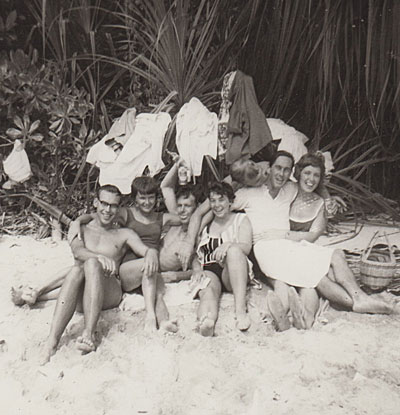
Beach parties, off to unoccupied sandy beaches on one of the many islands just off RAF Changi.

From: Peter Clayton, Wroughton, Wilts
Subject: Memories of RAF Changi
RAF Changi was my first overseas posting in May 1967 until November 1969, although I had previously made visits to my parents who were stationed at RAF Changi on 48 Sqn Hastings. I did two visits over Christmas holidays from boarding school as a boy and one for my 18th Birthday. My posting was a whole new world though, where I got to know the Changi Village bars such as Millie's Bar, The Europe Bar and I think it was The Airport Bar near Changi Creek Hotel. Then of course there was the famous Changi Restaurant "Recommended for The Forces" where you could buy a lovely Keema Curry and rice in a banana leaf and the curry in a carnation tin and take it to the beach. Of course it was a favourite place to eat in the evening as well or at one of several road side stalls.
The Telok Paku beach club was a favourite for spending many an hour drinking Tiger Beer as were the Malcolm Club and of course the NAAFI, Tiger I remember was 0.55c a pint and our exchange rate due to sterling devaluation was around $7.35 to the pound, so it did not take a lot to have a good session before maybe heading into Singapore from the 14.5 mile stone in a 'pick-up' taxi for around $1 I think it was.
Subject: Memories of RAF Changi
RAF Changi was my first overseas posting in May 1967 until November 1969, although I had previously made visits to my parents who were stationed at RAF Changi on 48 Sqn Hastings. I did two visits over Christmas holidays from boarding school as a boy and one for my 18th Birthday. My posting was a whole new world though, where I got to know the Changi Village bars such as Millie's Bar, The Europe Bar and I think it was The Airport Bar near Changi Creek Hotel. Then of course there was the famous Changi Restaurant "Recommended for The Forces" where you could buy a lovely Keema Curry and rice in a banana leaf and the curry in a carnation tin and take it to the beach. Of course it was a favourite place to eat in the evening as well or at one of several road side stalls.
The Telok Paku beach club was a favourite for spending many an hour drinking Tiger Beer as were the Malcolm Club and of course the NAAFI, Tiger I remember was 0.55c a pint and our exchange rate due to sterling devaluation was around $7.35 to the pound, so it did not take a lot to have a good session before maybe heading into Singapore from the 14.5 mile stone in a 'pick-up' taxi for around $1 I think it was.
I was working on Air Movements and used the Condec to load RNZAF Bristol Freighters, Britannia's, VC-10's and Hercules, we had several shifts and worked day and night shifts. Sometimes there were trips to Paya Lebar airport to pick up AOG spares etc when the scheduled RAF flights were not soon enough. I used some of my leave to go on solo trips with the RNZAF Bristol Freighters, one of which took me to Kuala Lumpur and onto Bangkok for a night stop, most of which I don't remember. The next day we went to Vientiane, Laos and onto Cheng Mai for another night stop; boy did those Kiwi's party! Next stop was Tan Son Nuit airport, Saigon and this was during the Vietnam war. On another trip in a Belfast we went up to Saigon and while we were offloading the aircraft, mortar bombs were landing on the airfield, some of which in the past had hit USA Jets parked in 'bomb pens' all around the airport, I really should look out my old slides and post some of the pics sometime.
Other trips included a week up to Kai Tak on my own, I stayed in the transit block but spent all day roaming around Hong Kong and Kowloon, it was a real experience. Little did I know then that my next overseas posting would be to RAF Kai Tak and indeed from there I did a trip back to Singapore! Other trips were made up to Penang, first by train for 24 hours and later by MSA Fokker Friendship F27 and then the Comet 4 of Singapore Airlines.
Other trips included a week up to Kai Tak on my own, I stayed in the transit block but spent all day roaming around Hong Kong and Kowloon, it was a real experience. Little did I know then that my next overseas posting would be to RAF Kai Tak and indeed from there I did a trip back to Singapore! Other trips were made up to Penang, first by train for 24 hours and later by MSA Fokker Friendship F27 and then the Comet 4 of Singapore Airlines.
I was paid fortnightly in cash in those days and of course this meant a visit to downtown Singapore, for such delights as Bugis Street and some of the famous bars in town, of course a round of chicken satay was a must and a few Tiger's. I went back to Singapore a few times when I was flying as a civil loadmaster and again for my 60th Birthday, when I was refused entry for afternoon tea in Raffles Hotel because I had shorts on! I did get the tea but in a not so posh lounge. It was good to see the old Britannia Club still standing but it is now used by the Singapore Armed Forces. Changi of course is the site for the wonderful Changi Airport, the village is still there and even one or two of the bars, including the Changi Restaurant!
So RAF Changi was probably my best ever posting with so many fond memories of the RAF Yacht Club, the village shops and bars, the noisy old buses into town and I have to say some really great colleagues both RAF and local labourers, not forgetting 'Pop' our Indian cleaner come errand runner and all round good chap.
Time is against me now to write even more before the deadline, I could not let this topic go by without putting in my bit, RAF Changi must have been one of the best overseas tours for so many. I loved Singapore and still do and would drop everything to go back again to ride their superb mass transit system and to sit in Newton Circus eating chicken satay or in Chinatown enjoying a Tiger or even the Indian quarter for a lovely curry served on a banana leaf! Happy days.
Peter Clayton
So RAF Changi was probably my best ever posting with so many fond memories of the RAF Yacht Club, the village shops and bars, the noisy old buses into town and I have to say some really great colleagues both RAF and local labourers, not forgetting 'Pop' our Indian cleaner come errand runner and all round good chap.
Time is against me now to write even more before the deadline, I could not let this topic go by without putting in my bit, RAF Changi must have been one of the best overseas tours for so many. I loved Singapore and still do and would drop everything to go back again to ride their superb mass transit system and to sit in Newton Circus eating chicken satay or in Chinatown enjoying a Tiger or even the Indian quarter for a lovely curry served on a banana leaf! Happy days.
Peter Clayton

New members who have joined us recently:
Jeremy Dumayne, Elder, SD
Paul Kavanagh, Ramsgate, Kent
Welcome to the OBA!

More Relevant Stuff
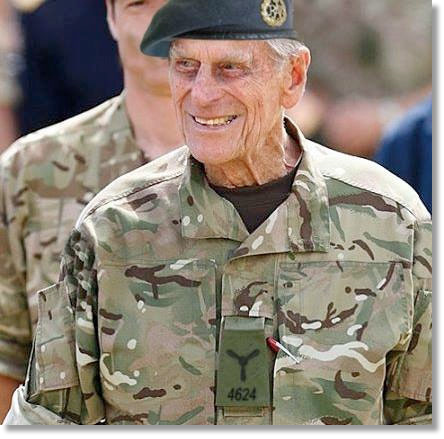
Now that Prince Philip has officially retired, he has
joined the RAuxAF's 4624 Movements Squadron!
joined the RAuxAF's 4624 Movements Squadron!
What you didn't know about officer's ration packs
From: David Moss, Sorbie, Dumfries and Galloway
Subject: Willy Marr's pipes
This is about an event that I had the honor to attend along with some fellow members of the Royal British Legion Scotland here in Newton Stewart earlier this month. It was the ceremony of the laying up of the bagpipes played by Willy Marr, a local man as he led the charges "over the top" in WW1 at the battles of Loos and The Somme. It was a very poignant and solemn occasion which I am sure brought a lump to the throats of many of those who were able to attend. Of the 165 local men who joined up from around here, Willy and his brother were two of only five who returned. I know this is not an RAF item but it was so good to be able to express in a small way, the gratitude we owe to so many who went and the few who came home.
Subject: Willy Marr's pipes
This is about an event that I had the honor to attend along with some fellow members of the Royal British Legion Scotland here in Newton Stewart earlier this month. It was the ceremony of the laying up of the bagpipes played by Willy Marr, a local man as he led the charges "over the top" in WW1 at the battles of Loos and The Somme. It was a very poignant and solemn occasion which I am sure brought a lump to the throats of many of those who were able to attend. Of the 165 local men who joined up from around here, Willy and his brother were two of only five who returned. I know this is not an RAF item but it was so good to be able to express in a small way, the gratitude we owe to so many who went and the few who came home.
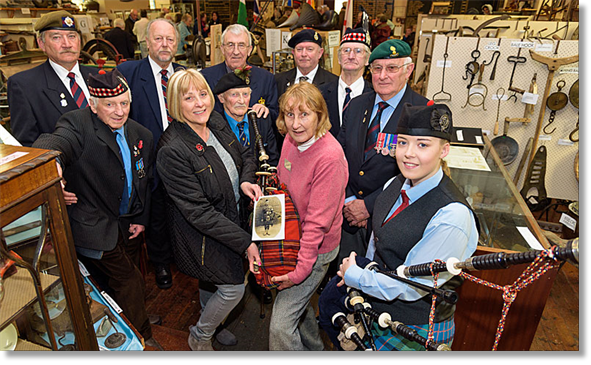
(Western) Traffic Tech Reunion
September 8th, 9th, 10th, 2017
Spallumcheen Golf & Country Club, Vernon, BC. Registration/Meet & Greet, Friday, Sep 8 16:00
Golf Tournament—Saturday, Sept 9th 10:00 (Executive Course)
Fees
18 Holes of Golf & Cart $35.00 pp
Steak or Chicken Dinner $25 pp
Meet & Greet Light Supper $5.00 pp
Final Hurrah —Sunday, Sept 10th 15:00 -The Dawson’s, 648 6th Ave, Desert Cove Estates (behind the golf course) BYOB
FOR ADDITIONAL INFORMATION
email Earle: herclm@earthlink.net or phone 250-545-0410
Spallumcheen Golf & Country Club, Vernon, BC. Registration/Meet & Greet, Friday, Sep 8 16:00
Golf Tournament—Saturday, Sept 9th 10:00 (Executive Course)
Fees
18 Holes of Golf & Cart $35.00 pp
Steak or Chicken Dinner $25 pp
Meet & Greet Light Supper $5.00 pp
Final Hurrah —Sunday, Sept 10th 15:00 -The Dawson’s, 648 6th Ave, Desert Cove Estates (behind the golf course) BYOB
FOR ADDITIONAL INFORMATION
email Earle: herclm@earthlink.net or phone 250-545-0410

From: Richard Allen, Llanmartin, Newport, Mon
Subject: Owain's Graduation
Subject: Owain's Graduation

Proud Parents: Caroline and Richard Allen with Owain who recently graduated
from basic training. Owain has commenced his Supply Trade Training
from basic training. Owain has commenced his Supply Trade Training
From: Konrad Putu, Wellington
Subject: What is an Airman?
Subject: What is an Airman?
What is an Airman? (author unknown)
Between the security of second childhood and the insecurity of childhood we find the fascinating group of humanity we call Airman. They come in all sizes, weights and states of sobriety. They can be found anywhere on various bases, in planes, in bars, in love, always in debt. Girls love them and so do publicans, towns and cities celebrate them and the government supports them. An Airman is laziness with a deck of cards, bravery with a tattoo, the protector of the earth, he has the brains of an idiot, the energy of a sea turtle, the slyness of a fox, the stories of a sea captain, the sincerity of a liar, the aspirations of a Casanova, and when he wants something its usually connected with leave. Some of his interests are girls, women, females, and members of the opposite sex. No one else can cram into one pocket a little black book, a wallet, a crushed ID card, a credit card, an odd leave pass and what’s left of last week's pay. He likes to spend his pay on women, some on beer, and cards and the rest foolishly. An Airman is a magical creature you can lock him out of your home, but you can’t lock him out of your heart. You can scratch him off your mailing list, but you can’t get him off your mind. He is the one and only blurry eyed good for nothing bundle of worry, but then all your shattered dreams become insignificant when he comes home looks at you with those blurry eyes and says “I love ya honey.”
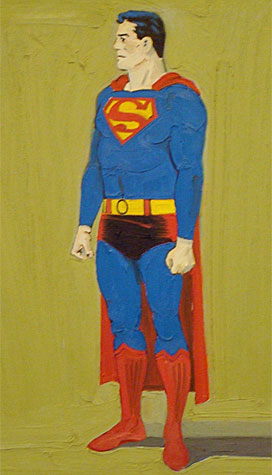
Bob Whitworth, Masirah
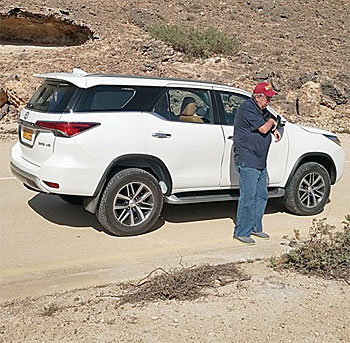
On the old Salalah to Thumrait Road
Charlie Marlow, Isle of Wight
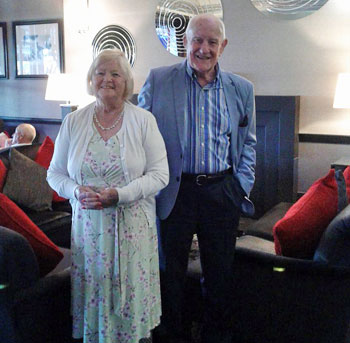
Charlie and Patsy celebrate their 58th
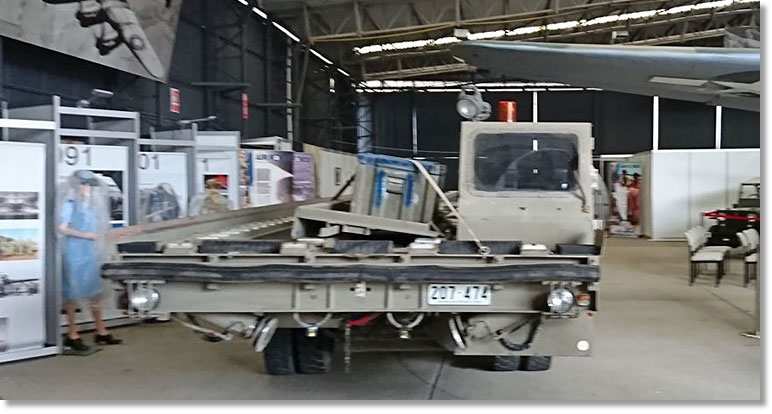
Our new exhibit at Amberley Aviation Heritage Centre
Truck, Aircraft, Loading and Unloading, (TALU) Registration No 207-474. This type of vehicle is used by the RAAF Air Load teams to load and unload various aircraft types including the C130 Hercules and C27J Spartan at Air Movements sections and detachments in Australia and overseas. I believe this particular one had been used in the Mid East area of operations until recently.
From: Vic Smith, Brassall, QLD
Notice to Airmen (NOTAM)
Are you enjoying reading the OBA Briefs every month?
Why not show your appreciation and make a donation to the cause?
Your support will help keep it online!
Why not show your appreciation and make a donation to the cause?
Your support will help keep it online!

From: Christopher Briggs, Coventry, West Midlands
Subject: Memories of RAF Changi
Hi Tony,
My memories of RAF Changi are from when I was at school out there between 1963 to 1966. We lived on the Toh Estate opposite a large expanse of green. It was the time when Indonesia had threatened to invade Singapore so the powers that be decided to strategically place a Bofors gun on the green to protect the area from any air attack. The British Goverment also sent out some Vulcans for an added deterrant; thankfully it never came to fruition.
Subject: Memories of RAF Changi
Hi Tony,
My memories of RAF Changi are from when I was at school out there between 1963 to 1966. We lived on the Toh Estate opposite a large expanse of green. It was the time when Indonesia had threatened to invade Singapore so the powers that be decided to strategically place a Bofors gun on the green to protect the area from any air attack. The British Goverment also sent out some Vulcans for an added deterrant; thankfully it never came to fruition.
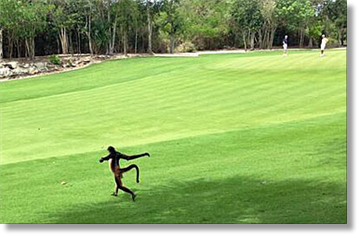
I remember going to see Manfred Mann, The Kinks and the Dutch Swing College Band at Badminton Hall in Singapore City. The act that stole the show was the Dutch Swing Colllege Band believe it or not - a superb night was had by all!
Lastly, playing golf at the RAF Changi course. If I remember correctly, the third hole was where we had to send the caddy ahead with a golf club as the hole was surrounded by trees and once the ball landed anywhere near the green the monkeys would come and steal it - hence the caddy sent up in advance!
Keep up the good work, it's great to see all the memories and so many names from the past!
Chris
Lastly, playing golf at the RAF Changi course. If I remember correctly, the third hole was where we had to send the caddy ahead with a golf club as the hole was surrounded by trees and once the ball landed anywhere near the green the monkeys would come and steal it - hence the caddy sent up in advance!
Keep up the good work, it's great to see all the memories and so many names from the past!
Chris
Tony Gale
ukmamsoba@gmail.com
ukmamsoba@gmail.com
This newsletter is
dedicated to:
Bill Gough (RAAF)
~and~
Graham Oke (RAF)
dedicated to:
Bill Gough (RAAF)
~and~
Graham Oke (RAF)
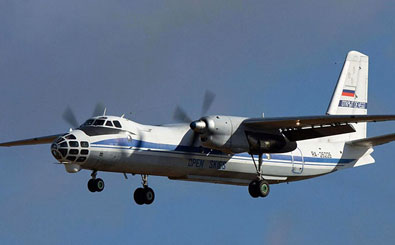
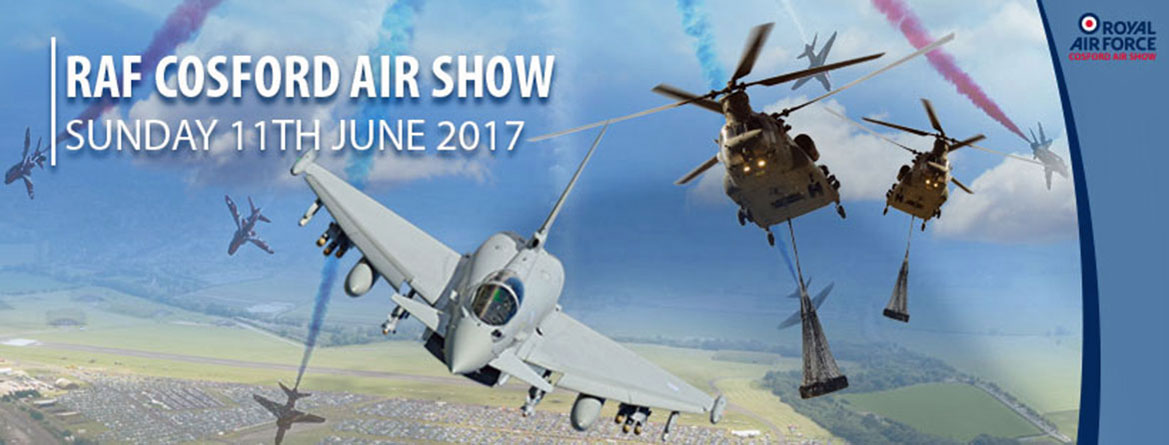

READY FOR ANOTHER ‘BUTT P’ ~ VALETTA VW863 ~ RAF CHANGI JUNE 1962
Valetta VW863 of 52 Sqdn from Butterworth being turned around at Changi on 15th June 1962. Crewed by Pilot Flt. Lt. G. Johnston, it carried out an air test at Changi before undertaking a Fed Ambulance flight from Changi to Ipoh. It is seen here after its return to Changi being prepared for its flight back to its base at Butterworth. VW836 required another air test again at Butterworth on the 17th before doing a ‘Butt P’ passenger flight from Butterworth to Malacca on the 18th, carrying on to Changi and then straight back to Butterworth under the crew of Fg. Off. A. Price. On the 19th she did a ‘Special’; going Butterworth to Changi and Seletar then to Malacca, before returning to Butterworth with the same pilot.
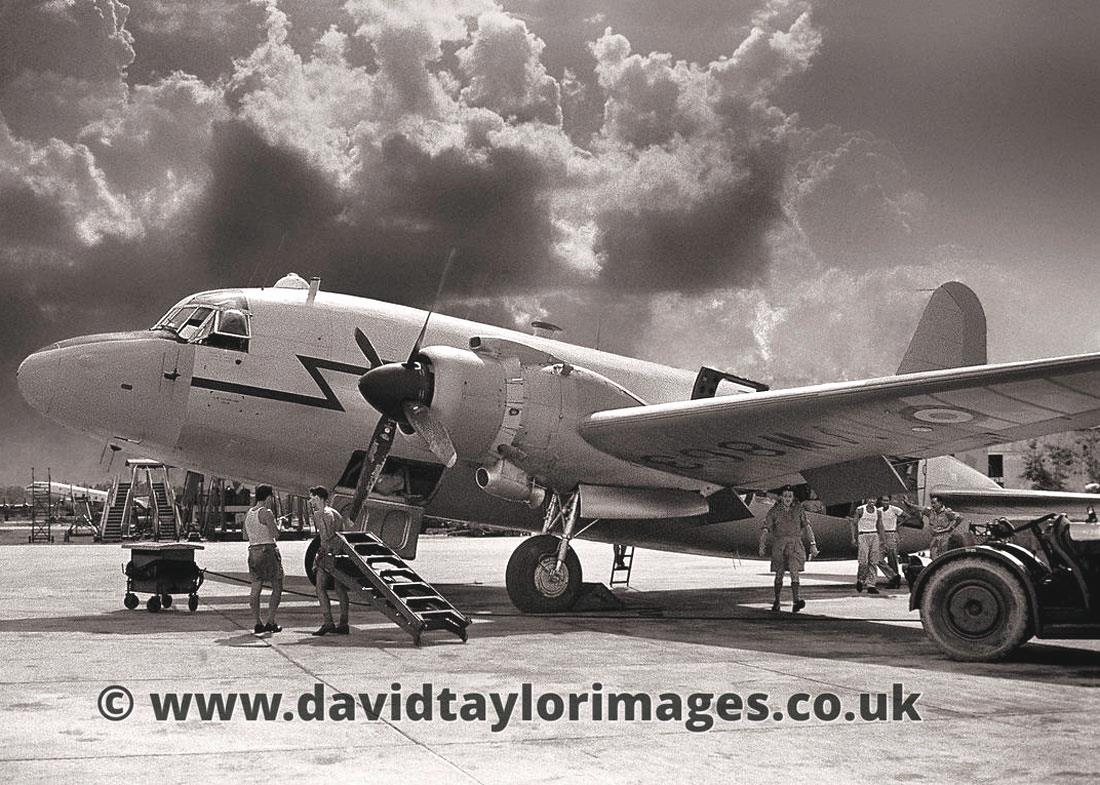
REFUELLING 40 SQDN’S VIP TRANSPORT ~ DC-6B NZ3631 ~ RAF CHANGI SEPTEMBER 1962
DC-6B NZ3631 being refuelled. Looking like it’s had a good polish. Of the three DC-6B’s of 40 Sqdn RNZAF, it was the one that was kept fitted out as a VIP transport and was later to carry the Queen on a tour of New Zealand in 1966 and also American President Lyndon Johnson the same year.
The RNZAF tried a few variations on their roundel and this DC-6 has a green fern frond on the centre red circle on the fuselage roundel. It was never very easy to discern and eventually a Kiwi was used.
The RNZAF tried a few variations on their roundel and this DC-6 has a green fern frond on the centre red circle on the fuselage roundel. It was never very easy to discern and eventually a Kiwi was used.
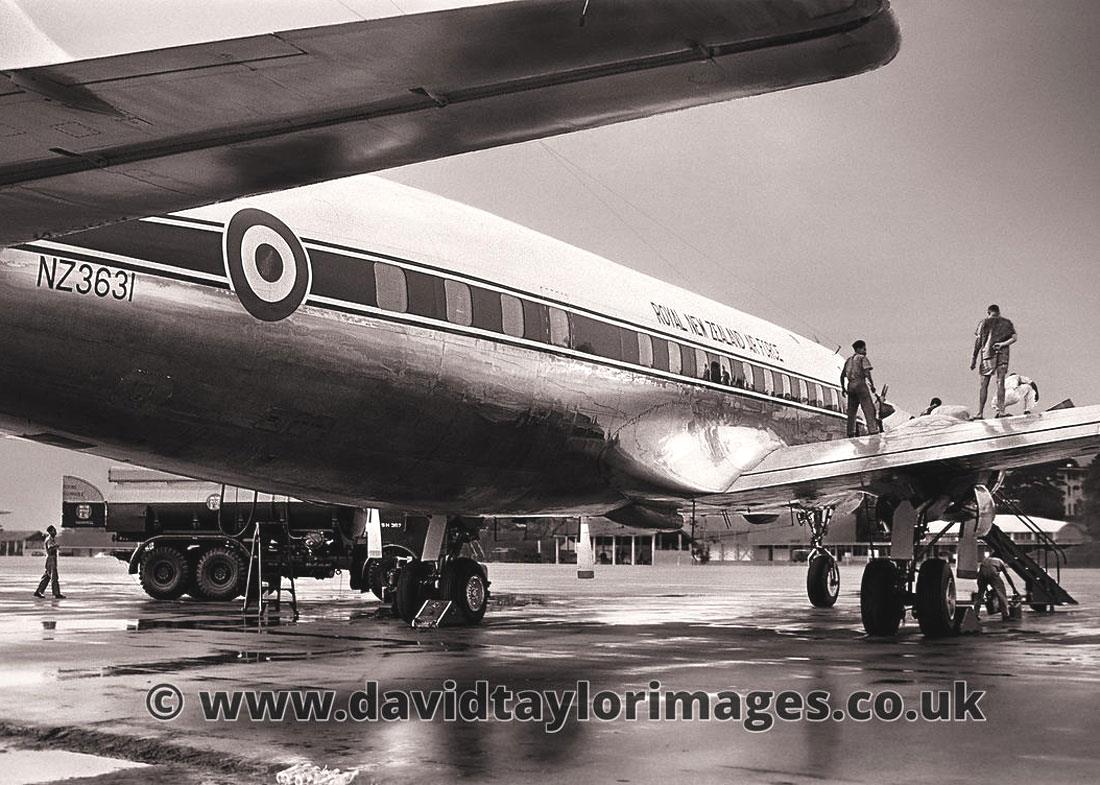
THE ARMY UNLOADS ~ DAN-AIR YORK G-ANXN ~ RAF CHANGI JANUARY 1963
Dan-Air York’s carried heavy freight and here an Army truck is unloading in Jan ‘63 when the continuing supply of the Army units in Borneo was still underway. G-ANXN, was ex-RAF MW258 and had flown this route through Singapore to Woomera in the late ‘50’s.
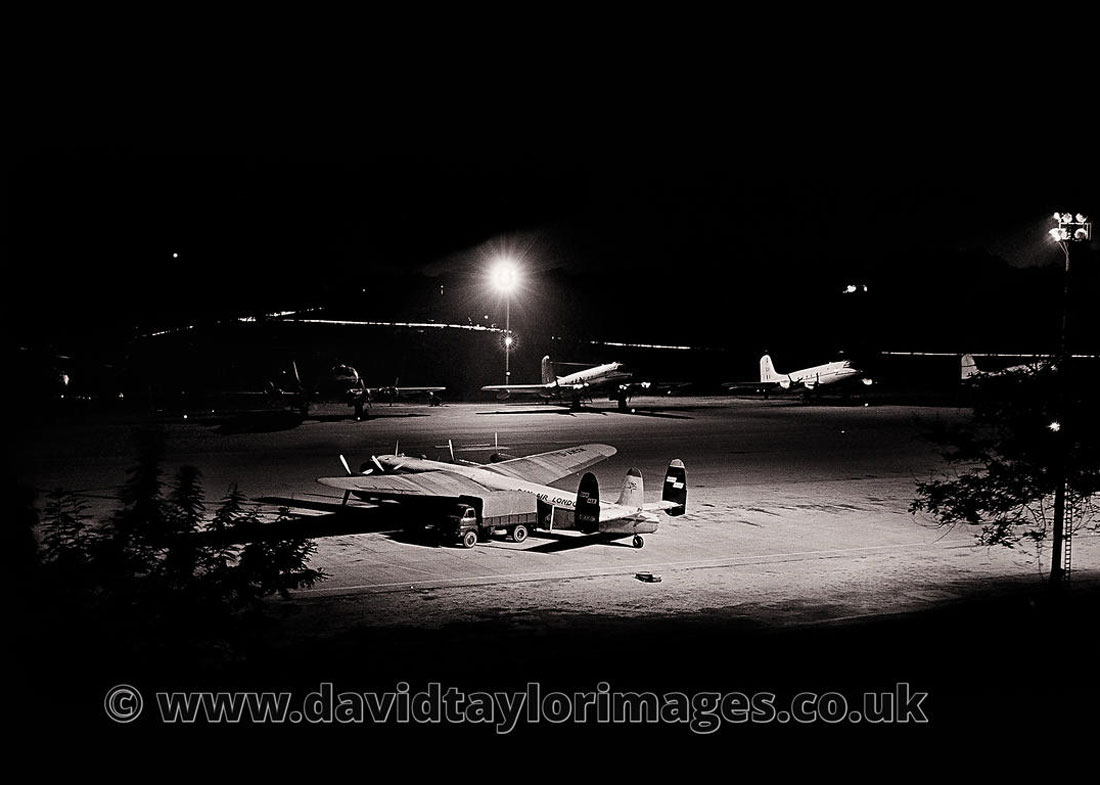
LOADING WITH THE 'BFLP' AT NIGHT ~ BRITANNIA XL640 ~ RAF CHANGI DECEMBER 1962
Britannia XL640 ‘Antares’ arrived at 2035 as Special Flight 6839 from Khormaksar via Gan on 14th December captained by Flt.Lt. C. Parent, an RCAF pilot on an exchange posting to 511 Sqdn.
It’s being loaded using the large Britannia Freight Lift Platform (BFLP) for an ‘Operation Ale’ flight to supply the personnel involved in the Brunei uprising.
This sudden burst of activity by the Britannia Force wasn’t without some problems as a couple of days later, on the 16th December, XM519 with a 511 Sqdn crew under Flt.Lt. Norman Rose suffered an out of control over-speeding prop on their No 4 engine after passing the ‘Point of No Return’, whilst en-route from Aden to Gan with three passengers and a load of Sea Slug missiles for Tengah.
The prop of No 4 engine refused to feather and was wind-milling in the 300 knots that the aircraft’s cruising speed so the Britannia had to slow to avoid the prop disintegrating. It descended from 17,500 ft to 1,500 ft and reduced speed to only 120 knots and Rose declared a full emergency.
He and his crew nursed the aircraft towards Gan with a very real fuel problem at the low altitude and amazingly it had insufficient fuel left for it to register on the flight deck gauges when it landed.
It’s being loaded using the large Britannia Freight Lift Platform (BFLP) for an ‘Operation Ale’ flight to supply the personnel involved in the Brunei uprising.
This sudden burst of activity by the Britannia Force wasn’t without some problems as a couple of days later, on the 16th December, XM519 with a 511 Sqdn crew under Flt.Lt. Norman Rose suffered an out of control over-speeding prop on their No 4 engine after passing the ‘Point of No Return’, whilst en-route from Aden to Gan with three passengers and a load of Sea Slug missiles for Tengah.
The prop of No 4 engine refused to feather and was wind-milling in the 300 knots that the aircraft’s cruising speed so the Britannia had to slow to avoid the prop disintegrating. It descended from 17,500 ft to 1,500 ft and reduced speed to only 120 knots and Rose declared a full emergency.
He and his crew nursed the aircraft towards Gan with a very real fuel problem at the low altitude and amazingly it had insufficient fuel left for it to register on the flight deck gauges when it landed.
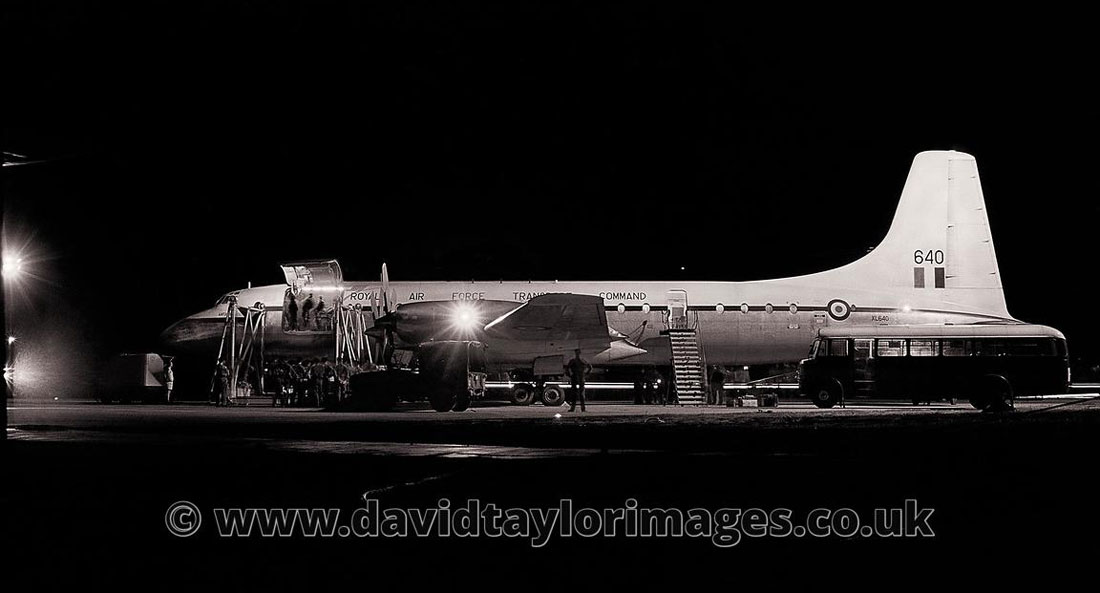
COMETS ‘LONG’ AND ‘SHORT’ ~ COMET C4 XR399 AND C2 XK697 ~ RAF CHANGI AUGUST 1962
Newly arrived Comet C2 XK697 ‘Cygnus’ parked beside one of the recently introduced larger Comet C4’s, XR399 on 1st August ‘62. Both were heading to Hong Kong the next day, with XK697 leaving Changi at 0925 and XR399 at 1335.
They crossed over at Changi again on the 4th August and returned the standard RAF route of Gan, Khormaksar and El Adem, with XK697 being the first home to Lyneham at 1235 on the 6th and XR399 arriving at 1820.
The following month, the C4 Comet’s took over the Far East run and the C2’s were relegated to the Middle and Near East so we stopped seeing both versions together at Changi.
The two Canberras were from 6 Sqdn RAAF based at RAAF Amberley in Queensland and were passing through on a navigation exercise to Butterworth. Amberley to Butterworth was disrupted during the Indonesian Confrontation in the early 1960s, so they then usually flew via Cocos Island, a route without much to navigate by. Fortunately there was a strong NDB beacon at Butterworth, so they steered ‘Northwest’ to miss the northern tip of Sumatra then turned towards Malaya to pickup a suitable bearing.
They crossed over at Changi again on the 4th August and returned the standard RAF route of Gan, Khormaksar and El Adem, with XK697 being the first home to Lyneham at 1235 on the 6th and XR399 arriving at 1820.
The following month, the C4 Comet’s took over the Far East run and the C2’s were relegated to the Middle and Near East so we stopped seeing both versions together at Changi.
The two Canberras were from 6 Sqdn RAAF based at RAAF Amberley in Queensland and were passing through on a navigation exercise to Butterworth. Amberley to Butterworth was disrupted during the Indonesian Confrontation in the early 1960s, so they then usually flew via Cocos Island, a route without much to navigate by. Fortunately there was a strong NDB beacon at Butterworth, so they steered ‘Northwest’ to miss the northern tip of Sumatra then turned towards Malaya to pickup a suitable bearing.
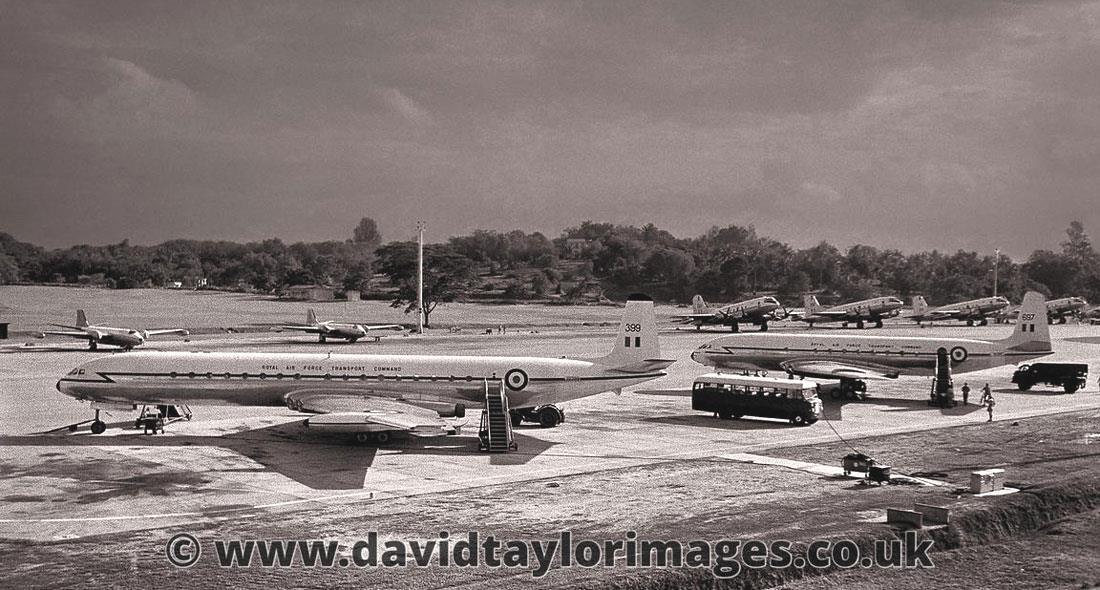
'SELF-LOADING FREIGHT' BOARDING ~ BRITANNIA XL638 ~ RAF CHANGI APRIL 1962
Service men and families walk out from the small Changi terminal to board Britannia XL638 ‘Sirius’ on 8th April ‘62. Crews jokingly referred to passengers as 'Self-loading Freight'! This was the second trip from Lyneham to the Far East in April and on this occasion a 99 Sqdn crew under Flt.Lt. J. Brown had left on the 26th routing to El Adem and Khormaksar. Here they 'slipped' and a 511 Sqdn crew captained by Flt.Lt. F. Baker took XL638 on to Changi via Gan.
On the same day that it had arrived, the 27th April, another 511 Sqdn crew under Flt. Lt. J. Hutton flew on to Darwin and the next day to Edinburgh Field then back to Darwin, with a similar flight to Edinburgh Field on the 29th and a return back to Changi. This time it was the turn of Flt.Lt Baker's crew to once again climb aboard the still warm XL638 and still on the 29th, as seen here, it left for Gan and Khormaksar where one more final crew would complete the flight home.
A Britannia left RAF Lyneham virtually every day for the Far East with the changing crews allowing rests and enabled keeping the aircraft usuage at it's maximum - the 'Changi Slip'.
It is just about possible to see that both ailerons and elevators on the Britannia hanging slightly down as amazingly the 'free-floating' power controls only became fully connected once the airflow over them reached a certain level during take-off.
The Aussie Hercules on the far-side has just been refuelled, as its bending wings show.
On the same day that it had arrived, the 27th April, another 511 Sqdn crew under Flt. Lt. J. Hutton flew on to Darwin and the next day to Edinburgh Field then back to Darwin, with a similar flight to Edinburgh Field on the 29th and a return back to Changi. This time it was the turn of Flt.Lt Baker's crew to once again climb aboard the still warm XL638 and still on the 29th, as seen here, it left for Gan and Khormaksar where one more final crew would complete the flight home.
A Britannia left RAF Lyneham virtually every day for the Far East with the changing crews allowing rests and enabled keeping the aircraft usuage at it's maximum - the 'Changi Slip'.
It is just about possible to see that both ailerons and elevators on the Britannia hanging slightly down as amazingly the 'free-floating' power controls only became fully connected once the airflow over them reached a certain level during take-off.
The Aussie Hercules on the far-side has just been refuelled, as its bending wings show.
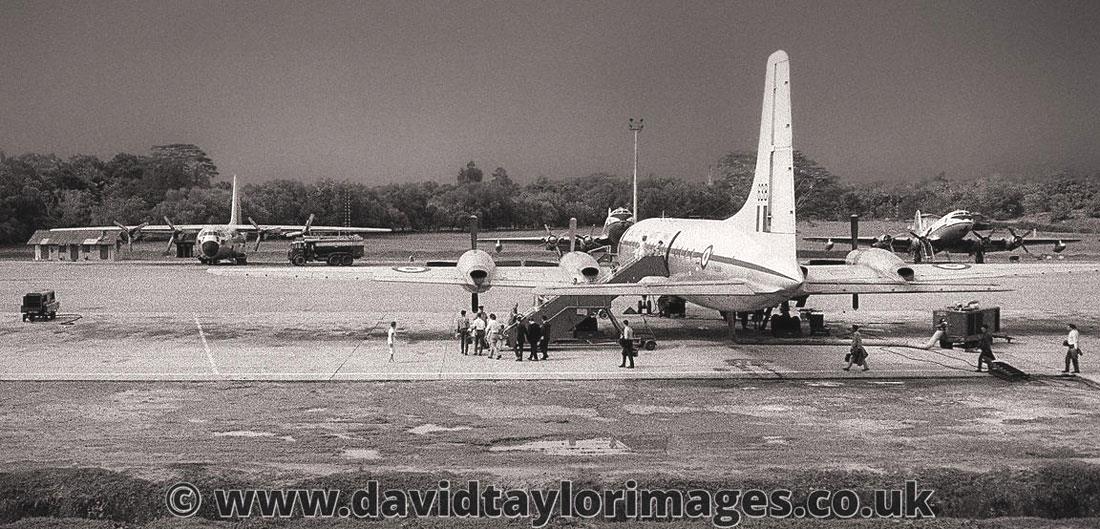
A SHACKLETON TAXIES PAST THE NEW ARGOSY'S OF 215 SQDN ~ ARGOSY'S XP448, XP450 ~ RAF CHANGI JULY 1963
Two of the ground crew of 215 Sqdn get a chance to look around their new Argosys XP448 and XP450, as Shackleton 2C WL741 ‘H’ of 205 Sqdn taxies out of the Eastern Dispersal that both squadrons were now sharing at the end of July 1963. There was ‘a bit of a rush’ to design the Argosy and also in order to save money, the wing had been based on that of the Shackleton; perhaps not a great decision. The RAF version was never fitted with the front opening door of the commercial versions, but it did have weather radar in that nosecone though.
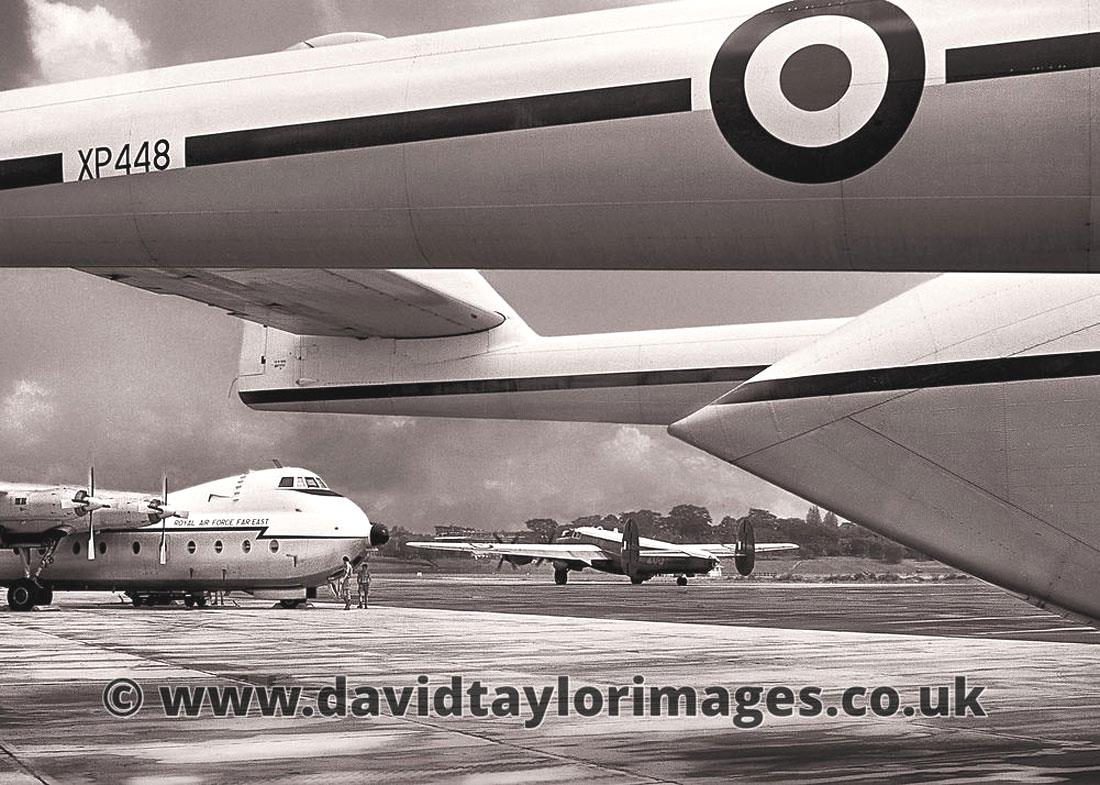
INGESTING A LAND ROVER ~ HASTINGS TG569 ~ RAF CHANGI DECEMBER 1962
48 Sqdn, like all the Singapore flying units, was suddenly involved in the Brunei crisis, ‘Operation Borneo Territories’. Rushing to get men and supplies to Brunei, the Army Dispatchers squeeze a Land Rover into Hastings TG569, at Changi on December 10th 1962. The crew of Captain Sqd.Ldr. M.Jenkins, with Co-pilot Flg.Off. J.Connell, Navigator Flt.Lt. C.Lougheed, M. Sig. M.Pattison, Engineer F.Sgt. R.Wakeham and the AQM Sgt. Hansford left at 1650 and got to Labuan at 2035 and were airborne back at 2225. The aircraft, along with many others did 2 flights the next day. Labuan airfield was located on an island off Brunei and was able to take large transports like the Britannia and even 205 Sqdn’s Shackletons were used as troop transports doing lots of runs as they could return without refuelling.

TWO BRITANNIAS ON THE APRON ~ RAF CHANGI FEBRUARY 1962
Two Brits plus a Comet, all from Lyneham on the pan at Changi on 20th February 1962. The nearest Britannia XN398 ‘Altair’, a C2 version, has just arrived with a crew from the other Lyneham based unit that used the pool of 23 RAF Britannias, the ‘Air Training Sqdn (Britannia)’. Britannia C1 XM520 ‘Arcturus’ behind was on the second of three trips into Changi in December. Coming on the 5th, 18th and also the 28th. It had flown from Changi to Kai Tak on the 19th and had recently returned. It left the next day with 511 Sqdn’s Flt.Lt. S.Goodwin and crew.
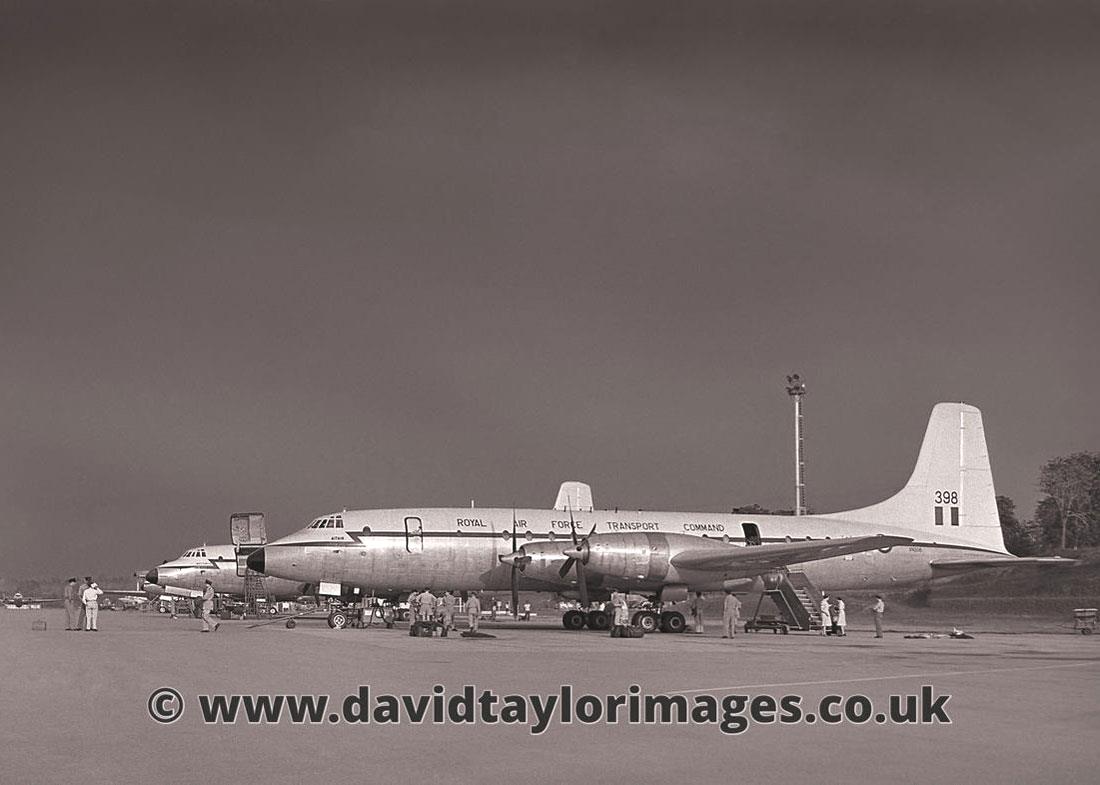
GETTING THE LOADING RAMPS OUT ~ BRISTOL FREIGHTER NZ5910 ~ RAF CHANGI SEPTEMBER 1961
One of the resident Bristol Freighters, NZ5910 of 41 Sqdn Royal New Zealand Air Force having it’s loading ramps assembled and is parked on the Far East Comm Sqdn end of the Western Dispersal, which still had ‘PSP’, a perforated steel plate surface at Changi in September ‘61. Bristol Freighters had been in use with the RNZAF for years and commercial freight company SAFE Air used them between Wellington on the North Island and Blenheim, on the South Island, starting in 1951.
The loading difficulties were considerably helped when SAFE Air started to use ‘Cargon’, a palletised cargo loading system, which was the first time pallets were used anywhere in the aviation world.
The loading difficulties were considerably helped when SAFE Air started to use ‘Cargon’, a palletised cargo loading system, which was the first time pallets were used anywhere in the aviation world.
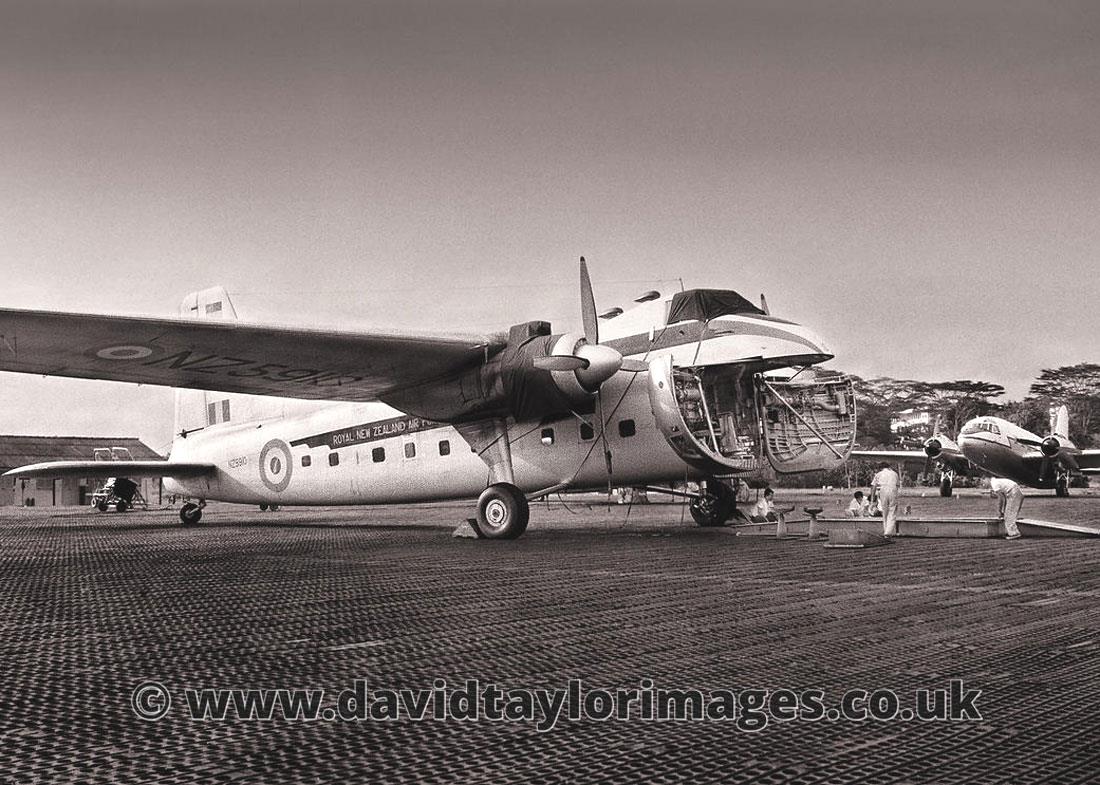
TRANSPORT COMMAND CHANGE THEIR SINGAPORE OPERATIONS BASE ~ BRITANNIA XM518 ~ PAYA LEBAR FEBRUARY 1963
RAF Britannia XM518 ‘Spica’ is marshalled out past Comet XR399 on 18th February ‘63. With RAF Changi closed during daylight hours for runway resurfacing the transport Command and visiting aircraft were using the civil airport at Paya Lebar and the ‘batman’ in his white overalls marshalling the Brit out was from the RAF servicing detachment, who were getting somewhat overworked as the predicted 24 Transport Command monthly movements had got up to 41 aircraft at Paya Lebar by July ‘63.
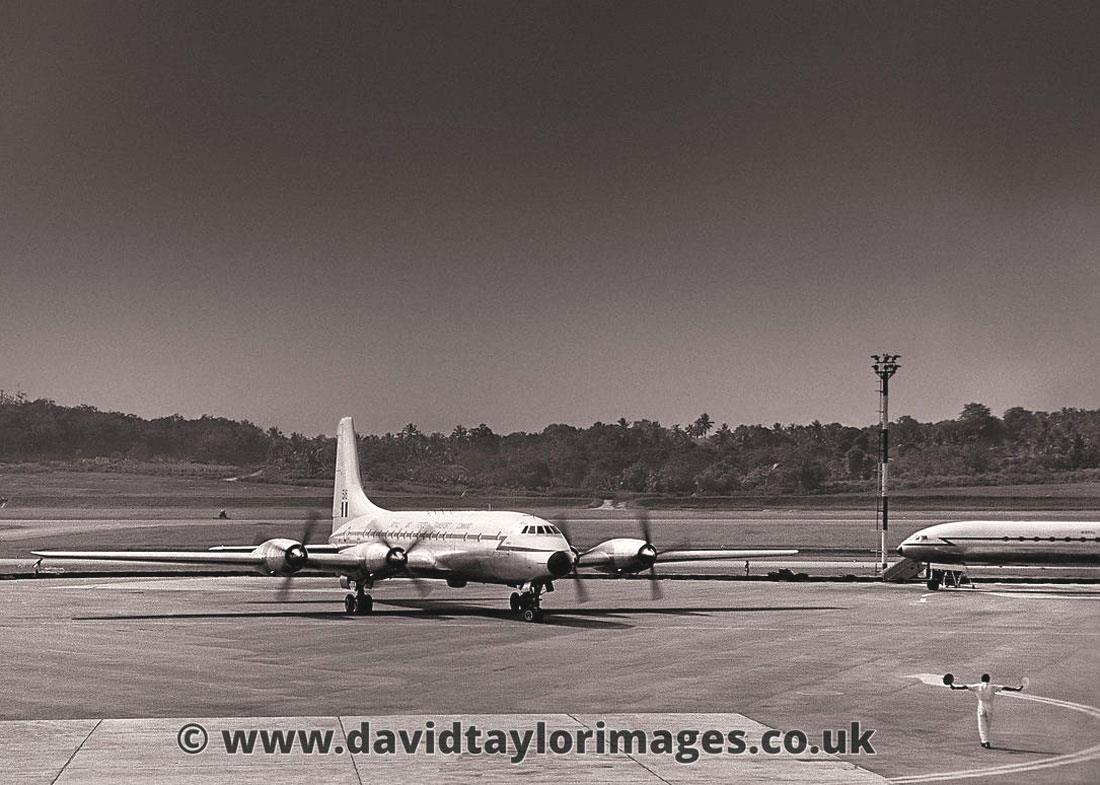
PARKING THE NAVY ~ ARK ROYAL SCIMITAR XD280 ~ RAF CHANGI SEPTEMBER 1962
Pushing 800 Squadron Scimitar XD280 ‘100’ into it's static display place the day before the 1962 Changi Airshow, alongside the Sea Vixen and Gannet also from Ark Royal. It’s equipped with a pair of AIM-9 Sidewinder missiles. Ark Royal was steaming back towards Singapore Naval Base and had experienced a period of strong seas that had caused a pause in flying.
[This image was included to illustrate the hideous and uncomfortable KD of the day. Those on Pax duties would have the KD starched!]
[This image was included to illustrate the hideous and uncomfortable KD of the day. Those on Pax duties would have the KD starched!]
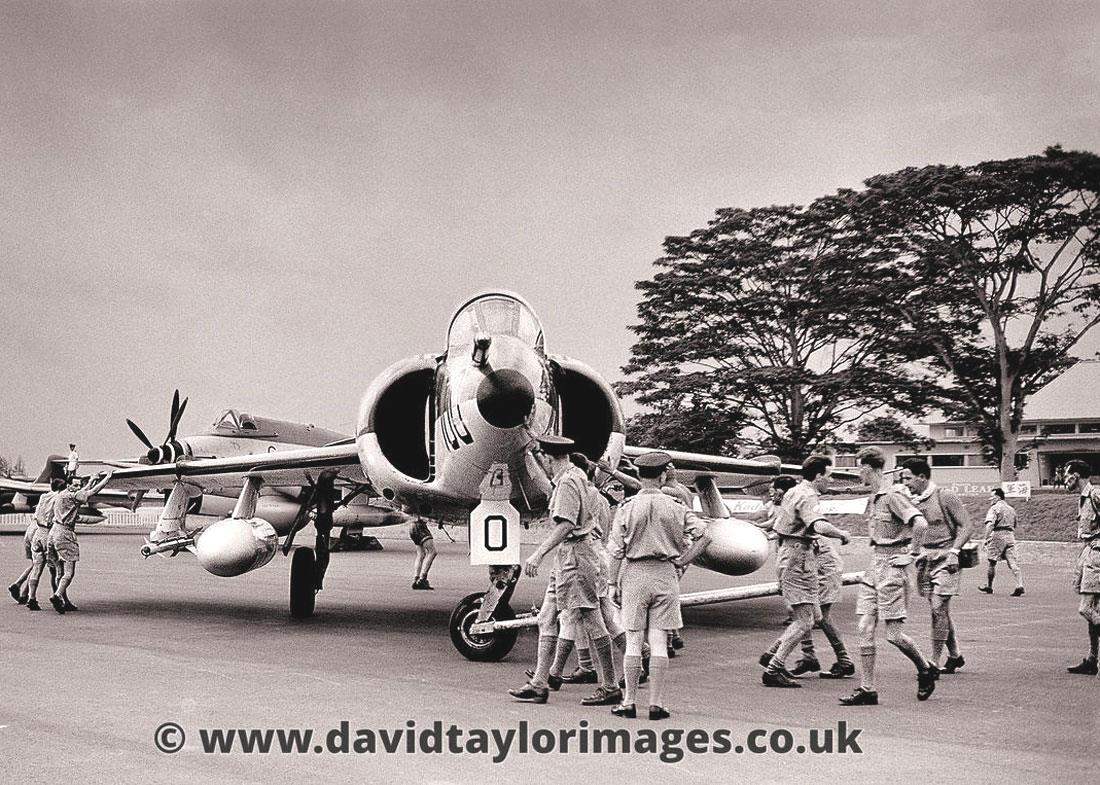
Who is David Taylor?
I'm a photographer based in Dorset, England.
The black and white image has more relevance to me, so I shoot monochrome as I prefer it's graphic nature and greater distance from reality. I have returned to using film, but not to the 'wet darkroom' as I relish the control that digital post production provides and using Jone Cone's 'Piezography' inks I am able to make superb monochrome prints that exceed the quality of any darkroom silver prints I could ever make.
I started photographing as a teenager when living in Singapore. I was able to photograph the aircraft that were based at, or visited the RAF station we lived at, however I soon got frustrated with the poor results I was getting. This was because of the sub-standard processing my negatives received and my father encouraged me to start developing and printing at home. My photography continued when I began working in television sound, a career which started at Anglia TV in 1966. However through my years in the 70's at London Weekend Television and at the independent studio Limehouse in the early '80s, my work and family life had to take precedence so I stopped serious photography. I entered a period of freelance TV mixing in the mid 1980's and then ran my own TV sound post production suite from 1996 until 2010. After my children left home I returned to photography with a digital camera but the real thrill of photography was finally rejuvenated by returning to using a Hasselblad film camera. It feels like 'picture making' again and not using a computer.
My greatest influence would be Michael Kenna. He photographs at the times of day, or more often night, when other photographers put their cameras away and I find the simple beauty of his 'minimal' images very compelling. Photography is often about 'what you leave out'.
Over the last few years I have returned to my earliest aircraft images and have now printed many of these and put them on my website. The more I delve into these old negatives the more I enjoy them so I hope others find the images I took 50 odd years ago pleasing.
David Taylor
The black and white image has more relevance to me, so I shoot monochrome as I prefer it's graphic nature and greater distance from reality. I have returned to using film, but not to the 'wet darkroom' as I relish the control that digital post production provides and using Jone Cone's 'Piezography' inks I am able to make superb monochrome prints that exceed the quality of any darkroom silver prints I could ever make.
I started photographing as a teenager when living in Singapore. I was able to photograph the aircraft that were based at, or visited the RAF station we lived at, however I soon got frustrated with the poor results I was getting. This was because of the sub-standard processing my negatives received and my father encouraged me to start developing and printing at home. My photography continued when I began working in television sound, a career which started at Anglia TV in 1966. However through my years in the 70's at London Weekend Television and at the independent studio Limehouse in the early '80s, my work and family life had to take precedence so I stopped serious photography. I entered a period of freelance TV mixing in the mid 1980's and then ran my own TV sound post production suite from 1996 until 2010. After my children left home I returned to photography with a digital camera but the real thrill of photography was finally rejuvenated by returning to using a Hasselblad film camera. It feels like 'picture making' again and not using a computer.
My greatest influence would be Michael Kenna. He photographs at the times of day, or more often night, when other photographers put their cameras away and I find the simple beauty of his 'minimal' images very compelling. Photography is often about 'what you leave out'.
Over the last few years I have returned to my earliest aircraft images and have now printed many of these and put them on my website. The more I delve into these old negatives the more I enjoy them so I hope others find the images I took 50 odd years ago pleasing.
David Taylor
The preceding images are just a tiny sampling of those that are available on my website (linked above). Please take the time to visit; you will not be disappointed. I would also love to hear from you and answer any questions you may have - you'll find my contact information on the website.









